Syro-Lebanese Economic Interpenetration







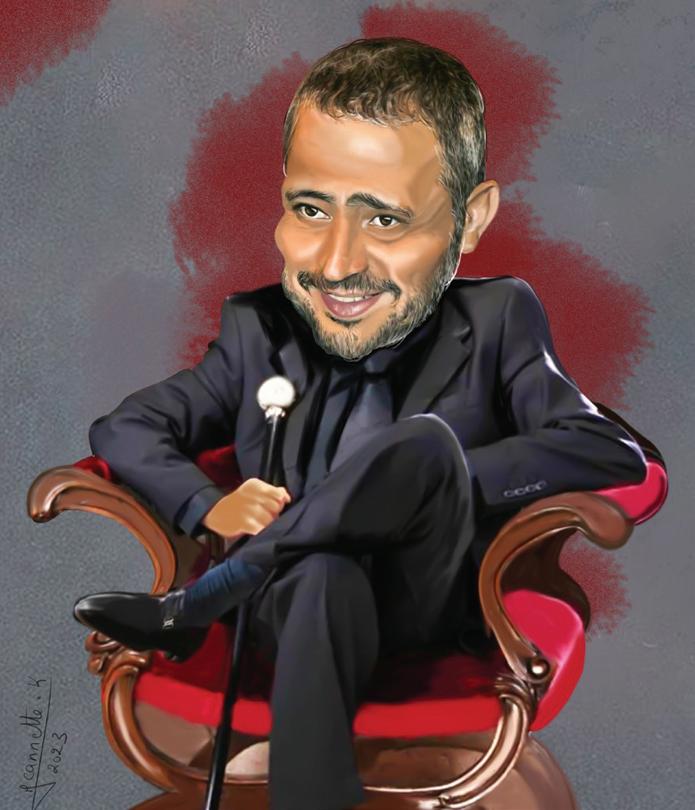

During the first days of the new year, Ukraine was attacked by dozens of Iranian Shahed-136 suicide drones, which revealed an obvious sign of a larger military collaboration between Tehran and Moscow. Suzan Quitaz writes about scale of the damage caused by the Shahed drones, their specifications which make them cost effective for the prolonged war on Ukraine. Quitaz also focuses on concerns that Iranian military deals are not only threatening to Ukraine and its immediate neighbors, but also to the volatile situation in the Middle East.
In the Economy Section, Motasem Al Felou gives an account of the “economic interpenetration” between Syria and Lebanon, which are sharing a currency collapse and consequences that have been mutually shared across the borders. Despite the different reasons and timespan for their economic deterioration, and the political conflicts specific to each of them, Syria and Lebanon shared a common economic history, and both should take serious steps to save their economies.
In the Culture Section, Bryn Haworth writes about the British royals being fed to the media and the public. In anticipation of Prince Harry’s book “Spare,” Haworth offers an insightful reading of the American and British take on Harry-Meghan saga.
In the Society Section, Wael Salem highlights the controversial announcement by the Egyptian government to set up a family fund that would help the State curb unwanted divorces, and maintain the interests of the children and spouses in case of separation.
Sarah Gamal also writes a feature about the Alexandria house of the most infamous murderers in Egyptian history, that has become a tourist destination.
Read these articles and more on our website eng. majalla.com. As always, we welcome and value our readers’ feedback and we invite you to take the opportunity to leave your comments on our website.
A Weekly Political News Magazine www.majalla.com/eng
Editor-in-Chief
The Editor Mostafa El-Dessouki


10th Floor Building 7 Chiswick Business Park 566 Chiswick High Road London W4 5YG
Tel : +44 207 831 8181Fax: +44 207 831 2310
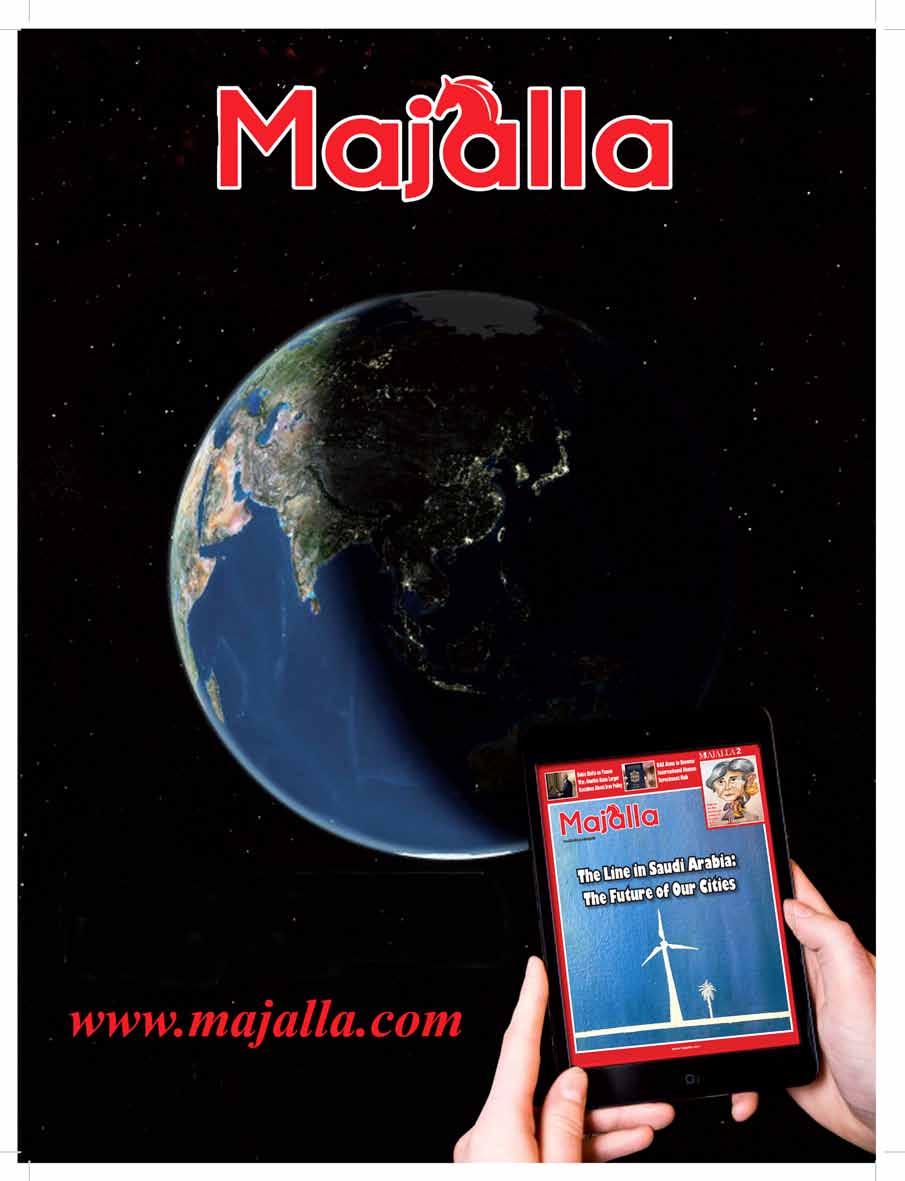



















People wearing costumes participate in the parade of the choreographic groups in tribute to Mother Earth during the Carnival of Blacks and Whites (Carnaval de Negros y Blancos) in Pasto, Colombia, 03 January 2023. EPA


The Egyptian pound weakened to 27.1 to the dollar this week, its biggest one-day move since the central bank allowed it to fall by 14.5% on Oct. 27, according Re nitiv Data. It was about 24.70 to the dollar at the opening of the trading day.
Currency exibility has been a key demand by the International Monetary Fund, which approved a 46-month, $3 billion nancial rescue package in October.
Egypt had been seeking the loan since March, after the economic fallout from the war in Ukraine aggravated a foreign currency shortage, causing a sharp slowdown in imports and a backlog of goods in ports.


Lebanon’s military tribunal on Thursday charged seven suspects in last month’s attack that killed an Irish peacekeeper when a group of armed local residents ambushed his convoy and opened re, o cials said.
The shooting took place near the town of Al-Aqbiya in southern Lebanon, a center of support for the Lebanese militant group Hezbollah, which has denied any role in the killing.
The attack killed Pvt. Seán Rooney, 24, of Newtowncunningham, Ireland, and seriously wounded Pvt. Shane Kearney, 22. The wounded peacekeeper was medically evacuated from Lebanon to Ireland. Two other Irish troops in the vehicle sustained light injuries.


Cristiano Ronaldo superstar new Nassr on Tuesday, saying the highest paid Ronaldo said around the surprising transfers could reportedly year. Al Nassr president not con rm two-and-a-half-year
“He is the best normal he salary,” Almuammar that he really money he will
Ronaldo was presented as the new signing of Saudi Arabian club Al Tuesday, with the team’s president Portugal great deserves to be the paid player on the planet. said he turned down “many clubs” world to complete one of the most transfers in the sport’s history, which reportedly earn him up to $200 million a president Musalli Almuammar would rm the exact gures in the two-and-a-half-year contract. best player in football history so it is will be the highest in terms of cost or Almuammar said. “This is something really deserves, so the amount of will take, he really deserves.”

The United Arab Emirates’ top diplomat met with Syrian President Bashar Assad on Wednesday, his second visit to Damascus as relations continue to thaw between the two countries.
Iraq's oil revenues in 2022 exceeded $115 billion, according to preliminary gures announced by the oil ministry on Tuesday -- a four-year high following a collapse in prices during the coronavirus pandemic.

Oil production accounts for some 90 percent of Baghdad's income, and the country is the second largest producer within the Organization of the Petroleum Exporting Countries (OPEC).
"The total revenue from the export of crude oil for the year 2022 amounts to more than $115 billion," Minister for Oil Hayan Abdel-Ghani said in a statement.
Iran’s president on Tuesday vowed to avenge the killing of the country’s top general on the third anniversary of his death, as the government rallied its supporters in mourning amid months of anti-government protests. Gen. Qassem Soleimani, the architect of Iran’s regional military activities, was killed in a U.S. drone strike in neighboring Iraq. He is hailed as a national icon among supporters of Iran’s theocracy, while the protesters have torn down billboards and defaced other images of him.
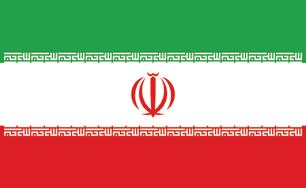
Thousands of people gathered to pay their nal respects to Brazil legend Pelé, as a funeral procession carrying his co n passed through the streets of Santos.

An ancient wooden sarcophagus that was featured at the Houston Museum of Natural Sciences was returned to Egypt after U.S. authorities determined it was looted years ago, Egyptian o cials said Monday. The repatriation is part of Egyptian government e orts to stop the tra cking of its stolen antiquities. In 2021, authorities in Cairo succeeded in getting 5,300 stolen artifacts returned to Egypt from across the world.
Pelé's co n was moved on a re engine from Vila Belmiro stadium, where it had been lying in state, through the streets, to the cemetery where he will be buried in a private ceremony.
Mourners lined the streets to say goodbye, with many wearing or holding up Santos shirts bearing Pelé's name.
Pelé - a three-time World Cup winnerdied at the age of 82 on 29 December.
Tunisia faces a year of low economic growth and runaway in ation, and urgently needs a bailout deal with the International Monetary Fund, its central bank chief said Wednesday. "We need to reach a deal with the IMF as soon as possible to mobilise external nance in the budget" or "2023 will be a complicated year", Marouane El Abassi told journalists in Tunis.
Ukraine's President Volodymyr Zelenskiy said Russia was planning to call up more troops for a major new o ensive, even as Moscow was facing some of its biggest internal criticism of the war over a strike that killed scores of fresh conscripts.
Kyiv has been saying for weeks that Russian President Vladimir Putin plans to order another mass conscription drive and shut his borders to prevent men from escaping the draft. "We have no doubt that the current masters of Russia will throw everything they have left and everyone they can round up to try to turn the tide of the war and at least delay their defeat," Zelenskiy said in his nightly video address on Tuesday.
India detected a total of 11 variants of COVID-19 in international travellers who arrived in the country during Dec. 24 to Jan. 3, health ministry sources said on Thursday.
China defended on Thursday its handling of its raging COVID-19 outbreak after U.S. President Joe Biden voiced concern and the World Health Organisation (WHO) said Beijing was under-reporting virus deaths. The WHO's emergencies director, Mike Ryan, said on Wednesday that Chinese o cials were under-representing data on several fronts, some of the U.N. agency's most critical remarks to date.
China scrapped its stringent COVID controls last month after protests against them, abandoning a policy that had shielded its 1.4 billion population from the virus for three years.
Iranian-made Shahed-136 drones attacking Ukrainian cities are the most obvious indicators to date that Iran has become a threat
to Ukraine and its European neighbors. According to the Ukrainian Foreign Ministry, Shahed drones have killed and wounded many civilians and have damaged hundreds of residential areas, power stations, bridges,

hospitals, sewage plants and schools in a number of Ukrainian cities.

On January 2, 2023, Ukrainian president Volodymyr Zelenskyy released a video address providing some insights into what he believes is Russia’s latest strategic weapon: the Shahed-136 drones aiming to ‘exhaust’ Ukraine. Zelenskyy said, “Only two days have passed since the beginning of the year, and the number of Iranian drones shot down over Ukraine is already more than eighty. This number may increase in the near future. Because these weeks the nights can be quite restless. We have information that Russia is planning a prolonged attack with Shaheds. Its bet may be on exhaustion. On exhaustion of our people, our air defense, our energy sector.”
Only four days earlier, on December 29, 2022, Ukraine was attacked by 16 Shahed drones with seven of them hitting the capital Kyiv. The first reports that Russia has been using Shaheds came to the surface around mid-September last year, when several drones were used against targets near Kupiansk, a city in the Kharkiv region, in Odesa and Mykolaiv. Again in October, they were used against civilian targets in the city of Bila Tserkva, south of Kyiv.
Shortly after the Bila Tserkva attack, Kyiv openly accused Tehran of supplying the Russians with Shahed drones. On October 11 of last year, Zelenskyy give a speech to the leaders of the G7, claiming that the Russians have purchased thousands of Shaheds. “The enemy used more than a hundred cruise missiles and dozens of different drones, including Iranian Shaheds. And every ten minutes I receive a message about the enemy’s use of Iranian Shaheds (…) according to our intelligence, Russia ordered 2,400 Shaheds alone from Iran,” said president Zelenskyy.
At first Tehran strongly denied the ac-
cusation calling it “baseless” and said it was ready for talks with Kyiv to clarify the matter. However, it was only two weeks later that Iran admitted it did supply Russia with a limited number of drones, claiming the drones were delivered “many months” before the Russian war against Ukraine started and that it has halted further deliveries.
Israel-Alma Research and Education Center, debunked the Iranian’s “many months” ago claim. It has collected data proving that the process of purchasing of Shaheds by Moscow began with a secret Russian delegation visit to the Kashan region of Iran in June 2022. Israel-Alma also rereleased a video on its twitter account showing that last August, Russian soldiers were taking part in training exercises in Kashan to learn how to operate unmanned aerial vehicles.
On December 10, 2022, US National Security Council spokesman John Kirby said that Iran is giving the Russians an unprecedented level of military support. Kirby stated that the partnership between Iran and Russia to produce drones is a dangerous development with devastating consequences not only to Ukraine but also to the entire world. “Russia is seeking to collaborate with Iran in areas like weapons development, training,” he said, adding that the US administration fears that Russia intended to “provide Iran with advanced military components” including helicopters and air de-
The first reports that Russia has been using Shaheds came to the surface around midSeptember last year, when several drones were used against targets near Kupiansk.
fense systems. He continued saying that “Iran has become Russia’s top military backer,” Kirby said.
Shahed-136 drones are unmanned aerial vehicles (UAVs) are also known as “Kamikaze” drones because they are destroyed in the attack and are so named
after the Japanese fighter pilots who flew suicide missions in World War Two.
The Shahed-136 is made by the Shahed Aviation Industries Research Center, which has ties to the Islamic Revolutionary Guards Corps Aerospace Force and the government-owned Iran Aircraft Manufacturing Industries Corporation.
The Shahed-136 officially entered service with the Iranian military in 2021. But the drone, its variants, and predecessors have reportedly also been used by Houthi rebels fighting in Yemen in recent years. Drones similar to Shahed-136 have been used against targets in the UAE and Saudi Arabia, such as the one in September 2019 which hit the Saudi oil installation in Abqaiq. The damage was so massive that the installation was shut down for two months.
Dr. Uzi Rubin, a leading expert on missile defense and a Senior Researcher
A view of drones during a military exercise in an undisclosed location in Iran, in this handout image obtained on August 24, 2022.
Iranian Army/WANA (West Asia News Agency)/Handout via REUTERS

Drones similar to Shahed- 136 have been used against targets in the UAE and Saudi Arabia, such as the one in September 2019 which hit the Saudi oil installation in Abqaiq.
a stone›s throw from the Chinese motherland. They were wrapped in the American protection that dominated the world after its sweeping victory in World War II, while China was suffering from the effects of Japanese occupation, and the high cost of Mao›s Red Revolution creeping up on Beijing›s walls. This began the first line of the story of the Chinese dragon›s rise to knock on the world›s doors after seventy years of hard work and success, claiming its right to international political influence as a result of its economic penetration into all continents.
The Chinese economy has almost surpassed America›s to become the world›s second largest, with the expectation that it will surpass it due to America›s budget deficit exceeding several trillion dollars.
Empires do not die of heart attacks, but of ageing symptoms that may appear early or late. This is the case with American and the Western leaders, as if it is the natural embodiment of the generational decline, where the leader has become only the one who is most popular and the most followed on social media.
Many objective observers regard Richard Nixon, the American president responsible for the Watergate scandal in the 1970s, as the last true American leader. The secret of his leadership resided in his ability to extract the American army from the quagmire of Vietnam and the agreement with the Soviets on military relaxation. Vietnam cost America the gold basis for the dollar after decades of the Cold War and chronic inflammation on the front lines.
Despite the adaptation of a communist ideology with doctrinal differences that allowed China to adopt capitalism to attract Western investments and technology without restrictions, Nixon›s final blow was attracting China away from the Russian orbit with the continuation of the communist rule over majority of the Chinese people. The Chinese have become a fuel for the gains of Western transcontinental companies that have adopted the theory of manufacturing innovations and new inventions in China to reduce costs and maximize profits. China was accommodating to this equation until it obtained a sufficient degree of Western technology to develop its own Chinese version. This was distinguished by a wide range of production, quality, and cost levels, in order
to invade global markets in both poor and rich countries with equal strength and scope. This was known as the “Chinese miracle,” which reached the pinnacle of its power with China›s recovery of the island of Hong Kong from the British crown, despite equivocations and sterile English quibbles.
Fear of the enemy, not faith in friends, is the foundation of any system in any era. As a result of the West›s fear of Russia›s growing power and its rapprochement with China, the Third World War erupted between the European allies led by America and the new eastern bloc with Putin›s military claw and the strong dragon economy. This conflict has clear goals, as the United States seeks to drain the eastern bloc militarily and economically, extend NATO to the east and reach the sources of oil and gas in Central Asia. Russia seeks to halt this expansion and assert its influence over the former Soviet republics, even if it necessitates a temporary alliance with Iran and neutralizing arch-neighbor Turkey.
As for China, it wants to reassert its influence in Southeast Asia and return Taiwan to the Chinese sphere of influence - whether through peace or war - and this is the essence of the conflict that is unfolding on the Ukrainian stage, as it did previously on the Cuban stage during the missile crisis.
Unfortunately, only the tip of the iceberg is visible, and what is hidden is much larger. The world is in need for Nixon-like American Leader and his advisor Kissinger - the fox - and the architect of the international accord, who sent the American pingpong (table tennis) team to play several matches in China as the first contact between China and the West. These games followed a secret operation to test waters that took place in Romania and Pakistan to bring out the scenario of sports exchange. Following that, the historical Chinese leader Mao invited US President Nixon to a historic visit to the Great Wall of China as a metaphor for China›s civilization extending back to the dawn of history in exchange for the modern American dream. Now, nearly seventy years later, the world›s most famous table tennis match is still delivering a historical sermon to world leaders. Its content could be that you can make a new agreement, gift the world with peace and prosperity, and enter history with a new game of ping pong.
to be mass-produced in Russia. If these reports are shown to be genuine, it could mean the production line could be up and running within few months and leading to a “long-term” war.
U.S. National Security Council spokesman John Kirby said “a relatively small number” of Iranian specialists are present in Crimea to improve Iranian drone performance. His words were echoed by Pentagon spokesman Brigadier General
Pat Ryder who said the Iranians are “assisting” the Russian personnel who pilot the UAVs.
The fact that both countries are moving even closer in the military and political fields, should be a concern not only to the neighbors of Ukraine. This should also ring alarm bells for the entire international community, and more specifically to Iran’s neighbors in the already politically volatile Middle East region. Iran’s supplying Moscow with Shaheds and deploying Iranian personnel on Russian soil are coming at a price, meaning Moscow may now be more open to supply Iran with technically superior and more lethal military hardware like Sukhoi Su35 fighter jets which Iran been keen to acquire.
This begs the question, why isn’t the Biden administration and its allies in NATO not taking decisive measures to strangle this Tehran’s military deals before it’s too late?
Local residents look at parts of an unmanned aerial vehicle (UAV), what Ukrainian authorities consider to be an Iranian-made drone Shahed-136, after Russian drone strike, amid Russia’s attack on Ukraine, in Kyiv, Ukraine October 17, 2022.
REUTERS/Vladyslav Musiienko
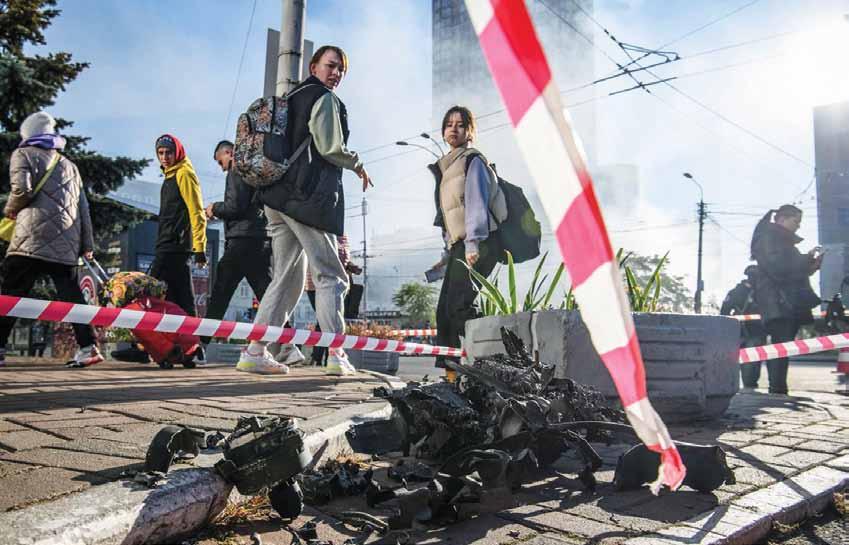
U.S. National Security Council spokesman John Kirby said “a relatively small number” of Iranian specialists are present in Crimea to improve Iranian drone performance.
FILES) This file photo) taken on February 11, 2016 shows Iranians walking past an Iranian Shahed 129 drone during celebrations in Tehran to mark the 37th anniversary of the Islamic revolution. - Canada targeted on November 16, 2022 Iranian makers of drones that Kyiv and the West say have been used by Russia to attack Ukraine in a rollout of new sanctions against the Islamic republic. The two companies -- Shahed Aviation Industries and Qods Aviation Industries -- «are key to the regime›s ongoing activities aimed at destabilizing international peace and security,» Foreign Minister Melanie Joly said in a statement. (Photo


Last month, the United States Supreme Court, the top interpreter of the American Constitution, stopped an expected tsunami of illegal immigrants on the border with Mexico. Television and social media videos have been showing long lines of people who wanted to cross the borders, people who have already crossed and are waiting to be seen by border officials, and people who became creative in jumping over the high walls that were built by former president Donald Trump.
Recent statistics show that about 500,000 people are waiting in
Mexico to cross the border; about 3,000 succeed in crossing every day; and about 900,000 have already crossed during 2022.

In 2007, according to U.S. government reports, illegal immigrants in the U.S. numbered about 12 million people, or about 5% of the total U.S. population. On top of this, visa-overstays (persons who entered legally but didn’t leave) reached about two million.
In 2012, government reports showed that 52% of the immigrants were from Mexico, 15% from Central America, 12% from Asia, 6% from South America, 5% from the Caribbean, and another 5% from Europe and Canada.
In 2016, U.S. government reports showed that approximately twothirds of the illegal immigrants who already crossed had lived in the
U.S. for a decade or longer, making them “almost citizens.”
The Supreme Court’s decision not to end “Title 42,” a law that former president Trump had issued to stop illegal immigrants from crossing and to turn them back because of COVID 19, might be just a short-lived step on the face of the formidable problem of illegal immigration.
Following are two opposed opinions about the issue, from the leaders of two major immigrant lobbying groups in the U.S.:
On one side, Daniel Stein, an attorney, anti-immigration advocate and president of the Federation for American Immigration Reform (FAIR).
On the other side, F. Daniel Siciliano, chairman of a bank in California, and president of the American Immigration Council (AIC). He was director of Corporate Governance Center at Stanford University and former professor at Stanford Law School.
“FAIR is fighting to restore common sense border controls, and an immigration policy that works for America and the future of all Americans.
Over the past year, America’s immigration and border controls have fallen apart due to ineffective leadership from Washington. We face a true national emergency! There is no time to lose.
The American way of life and the future of our natural environment and resource base depend on restoring the proper balance between our needs and the unlimited demands of millions on the move …
“On Monday, The American people and communities all across the country were spared even greater hardship at the hands of the Biden administration by the U.S. Supreme Court’s eleventh hour stay that prevents the federal government from cancelling Title 42.
Because the Biden administration has arbitrarily canceled, or refused to enforce, every policy designed to deter mass illegal immigration, Title 42, a public health provision that was invoked at the onset of the COVID pandemic, remains the only functioning policy preventing unchecked illegal immigration.
Already, the Department of Homeland Security was bracing for exponentially larger numbers of migrants pouring across the border illegally. And even with Title 42 remaining in place, the administration decision to exempt large categories from removal under the provision will not be enough to restore order to the border …
“The Supreme Court stay is a welcome reprieve, but there is still far more that needs to be done to regain control of our borders, and end the humanitarian crisis that the Biden administration has created.
Maintaining Title 42 will allow the new Congress, in which Republicans will control the House of Representatives, to address the dire situation stemming from the Biden administration’s refusal to enforce countless immigration laws …
“In 2020, the Supreme Court handed down a decision affirming that it is a crime to encourage illegal immigration … “Unfortunately for the Americans and foreigners victimized by
these scammers, activist lawyers seem determined to let them defraud the public …”
“The American Immigration Council (AIC) works to strengthen America by shaping how America thinks about and acts towards immigrants and immigration. And by working toward a more fair and just immigration system that opens its doors to those in need of protection and unleashes the energy and skills that immigrants bring …
“We believe that immigrants are part of our national fabric, bringing energy and skills that benefit all Americans. And we envision an America that values fairness and justice for immigrants and advances a prosperous future for all.
We have a proud—and complicated—history as a nation of immigrants.
Our immigration system and the way it treats immigrants often fail to live up to our highest values and ideals …
“Not only have we failed, in many cases, to afford basic due process rights, but in countless ways, our outdated immigration laws and policies do not respect the family unit, discourage innovation, and turn away those in need of protection ...
“The United States has long guaranteed the right to seek asylum to individuals who arrive at our southern border and ask for protection.
But since March 20, 2020, that fundamental right has been largely suspended. Beginning on that date, both migrants seeking a better life in the United States and those wanting to apply for asylum have been turned away and “expelled” back to Mexico or their home countries.
Over 1.8 million expulsions under Title 42 have been carried out since the pandemic began. However, nearly half of those expulsions were of the same people being apprehended and expelled back to Mexico multiple times …
“Supreme Court Chief Justice John Roberts temporarily halted the end of the Title 42 policy that allows the U.S. to expel migrants at the southern border without the chance for asylum. But (the) decision is procedural and does not indicate how the court will ultimately rule on the request for an emergency stay…”

The Supreme Court’s decision not to end “Title 42,” a law that former president Trump had issued, might be just a short-lived step on the face the formidable problem of illegal immigration.Central American immigrants take part in a caravan heading to the United States on the road linking Ciudad Hidalgo and Tapachula, Mexico, on October 2018 ,21. Pedro Pardo / AFP
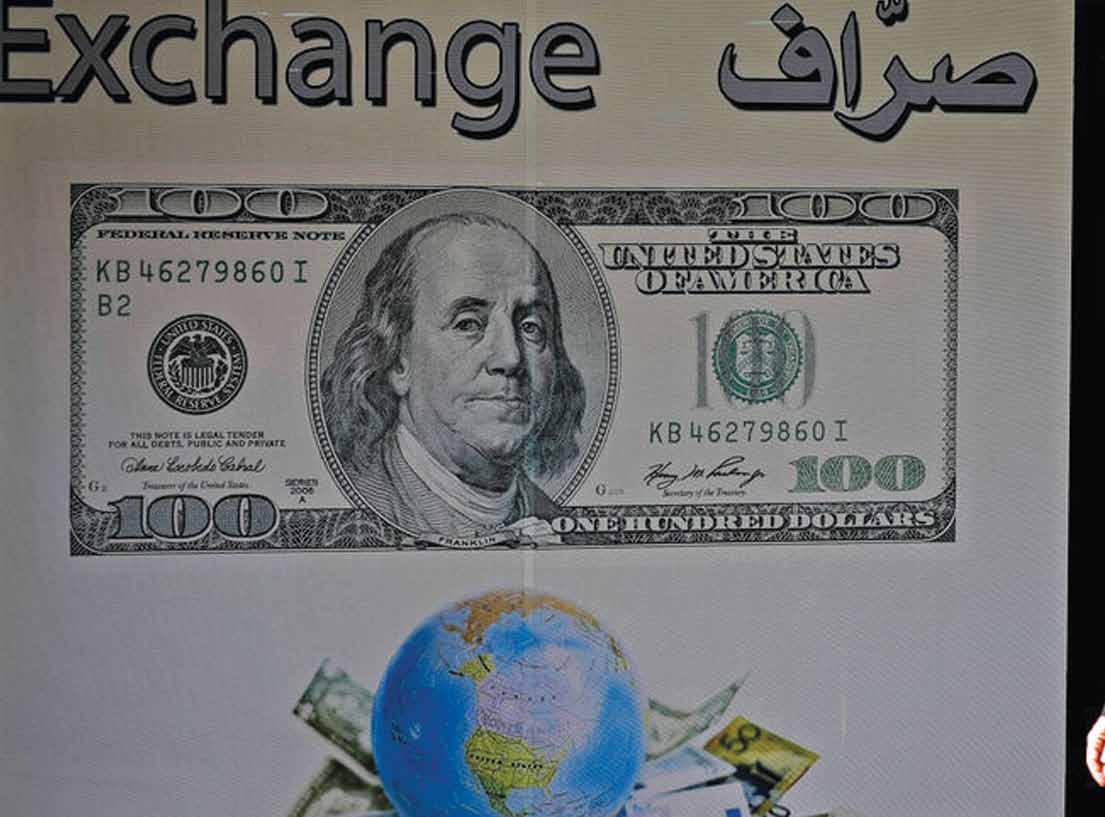
“I worked in Byblos (West Lebanon) for over 20 years. I used to make USD 50 a day. After the 2019 Lebanese banking sector collapse, my employers did not have access to their money in the banks, and could not pay me. Since then, my life turned upside down
and I had to move back to Damascus. Both countries are suffering from terrible economic problems,” Mohammed Asad, a previously Lebanon-based Syrian construction worker in his forties, told Majalla. Asad is one of hundreds of thousands of Syrian workers, who made their way back to their homeland after the economic and financial collapse of Lebanon fol-
lowing a series of demonstrations at the end of 2019.
It was not only Syrian workers who took the blow after the Lebanese collapse, Syrian business people and wealthy elites were also victims. Antoine, a Damascene business person, said: “My money in Lebanese banks is gone! Maybe forever. Before the Syrian Crisis of 2011, I used to make around USD 800,000 a year. Now, I hardly make USD 50,000 every year, with the Syrian pound’s value going down month after month.”
Syria claims that between 11% and 23% of the total deposits frozen in the Lebanese banks, which are estimated at USD 170 billion, belong to Syrian citizens. However, the percentage does not exceed 6% according to Lebanese sources. It is worth noting that the forecasted spending of the 2023 Syrian budget is estimated at SP 16.5 trillion (USD 2.8 billion). The last Lebanese approved budget of 2022 (ironically approved last September) has a spending of USD 1.1 billion.
Both the Syrian and Lebanese national currencies recorded huge losses in value in 2022, a matter that is making daily life harder for governments and people for different reasons. How is the Syro-Lebanese economic interpenetration affecting each country?
In the 1920’s, Syria and Lebanon had a unified central bank and currency as both were under the French mandate. In the early 1950’s, a complete separation took place between the two currencies.
After the declaration of the United Arab Republic (UAR was a temporary union between Egypt and Syria from 1958-1961), socialist policies were adopted in liberal-economy Syria and nationalization included major financial, industrial and agricultural activities. Huge amounts of Syrian capital migrated to the nearest country that was built on a market economy, namely Lebanon, to avoid nationalization. Since then, Lebanon has become the financial lung of Syria. Why?
After the Syro-Egyptian union was over, Syria continued its transformation towards socialism, especially after the Baath Arab Socialist Party assumed power in 1963. On the other side of the

border, Lebanon continued its role as the bank of the capitalist sector of the Syrian economy. Whenever there were socialist restrictions on the movement of capital, money transfers, imports and exports, the Lebanese banks used to serve the two countries. Syria’s access to the global economy has been gradually eliminated since 1979 when it was classified as state sponsor of terrorism. During the Lebanese Civil War (19751990), Lebanon kept playing a vital role in providing consumer goods to Syria, which maintained a military presence in Lebanon until the troops were forced to evacuate in 2005.
In 2005, Syria adopted a social market economy and opened up major sectors for local and foreign investments. Seven Lebanese banks opened branches in Syria. A few thousand Lebanese executives, specialists and investors moved to Syria to benefit from the economy’s partial liberalization, according to multiple sources, After the eruption of the Syrian Crisis 2011, the European Union and the US imposed unprecedented sanctions, targeting major sectors. The Syrian business sector had to rely more on the Lebanese banks to circumvent sanctions. In 2019, the Lebanese banking sector went broke and the Lebanese banks were not functional as before. In the following year, the Port of Beirut was destroyed by a powerful blast, furthering the suffering of Syrian importers who used the Lebanese port.
“My late dad was a taxi driver between Syria and Lebanon since the 1960’s. Syria, as a socialist country, had restrictions on imports of luxury goods and foods. He used to fill his car with products and sell them in Syria. I have been doing the same for 17 years,” said Ammar, a Syrian taxi driver.
Currently, all Syrian banks are out of the global
Despite the difference between the political conflicts in Syria and Lebanon, both countries need to take serious steps to save their economies.
banking system, and the Lebanese banks are paralyzed and broke!
Both the Syrian and Lebanese pounds have started a journey of continuous decay for different reasons and times. “Since the beginning of the Syrian Crisis of
2011, the national currency started to lose its value due to the military and political conflict. Western sanctions have made hard currency less available in the local market and capital found its way out of war-torn republic. The more demand for the American currency, the more Syrian pounds are offered,” Ibraheem Mohammed, a Syrian economy observer, told Majalla.
“When the Caesar Act was approved in 2020, the Syrian pound got a hard blow. People have become more skeptical about the future and the national currency has become less attractive,” he added.
In January 2022, one US dollar used to equal 4,000 Syrian pounds. The same year concluded with huge losses in value and now you need 6,000 Syrian pounds to get one US dollar. As far as Lebanon is concerned, this country has entered a vicious circle of debt since the early 1990’s. The national debt has reached over USD 100 billion. After a series of demonstrations at the end of 2019, banks announced they went broke and couldn’t fulfil their obligations towards their customers. As a result, tens of thou-

Syria claims that between %11 and %23 of the total deposits frozen in the Lebanese banks, which are estimated at USD 170 billion, belong to Syrian citizens. However, Lebanese sources say it does not exceed %6.Syrian employees stack packets of Syrian currency in the Central Syrian Bank in, Damascus, Syria. (AP)
sands of Syrian customers were denied access to their bank accounts, making their lives more complicated.
In January 2022, one USD equaled around 20,000 Lebanese pounds. Now, one dollar makes over 40,000 pounds.
The ongoing value deterioration of both the Syrian and Lebanese pounds has made product and service prices skyrocket. Even the prices for locally-made products and services got higher due to the inflation of foreign input.
“The problem with the continuous de-valuation of the national currencies of Syria and Lebanon, is that the cost of goods increases and demand gets weaker. The Syro-Lebanese markets are more fragile than ever,” said a Lebanese merchant based near the LebaneseSyrian border.

Despite the difference between the political conflicts in Syria and Lebanon, both countries need to take serious steps to save their economies. According to Syrian sources, hundreds of com-
panies owned by foreign investors were licensed last year. However, they are not yet functional.
Hanna is a Lebanese investor I met a few weeks ago. He opened a Japanese sushi restaurant in the coastal city of Latakia.
“I opened the restaurant because I believe in the future of Syria. There are always people who can afford paying USD 20 or 30 for a meal. I brought a Lebanese sushi chef and I am optimistic,” said Hanna.
“I started this year. Others may not find a place in the competition in 2023!” he concluded.
It was not only Syrian workers who took the blow after the Lebanese collapse, Syrian business people and wealthy elites were also victims.

The dramatic, multidimensional implosion of Meta; the nuclear train wreck of Elon Musk’s Twitter; the momentous labor uprising against Amazon—it wasn’t just an unusually disastrous year for America’s biggest tech companies. It was
a reckoning.
The tech giants that have shaped our lives, online and off, over the course of the 21st century have at last hit a wall. Amazon, Alphabet, Microsoft, Meta, and Apple all saw their valuations fall, sometimes precipitously. Many slashed their workforces; at least 120,000 tech workers lost their jobs this year.
The myth of the genius founder, which insulated so many of these giants from so much criticism for so long, was debunked before our eyes.
These companies, launched with promises to connect the world, to think different, to make information free to all, to democratize technology, have spent much of the past decade making the sorts of moves that large corporations trying to grow ever larger have historically made—embracing profit over safety, market expansion over product integrity, and rent seeking over innovation—but at much greater scale, speed, and impact. Now, ruled by monopolies, marred by toxicity, and over-reliant on precarious labor, Silicon Valley looks like it’s finally run hard up into its limits.
Call it the improbable paradox of the modern tech giant. Some of the most powerful, profitable, and expansive companies in human history—associated at least nominally with wide-ranging innovation—are stuck. They’re failing utterly to create the futures they’ve long advertised, or even to maintain the versions they were able to muster. Having scaled to immense size, they’re unable or unwilling to manage the digital communities they’ve built. They’re paralyzed when it comes to product development and reduced to monopolistic practices such as charging rents and copying or buying up smaller competitors. Antitrust investigations beckon. Their policies tend to please no one; it’s a common refrain that antipathy toward Big Tech companies is one of the few truly bipartisan issues.
You can just feel it, the cumulative weight of this stagnation, in the tech that most of us encounter every day. The act of scrolling past the same dumb ad to peer at the same bad news on the same glass screen on the same social network: This is the stuck future. There is a sense that we have reached the end of the internet, and no one wants to be left holding the bag.
How these companies respond to this troubled new era will have major repercussions. This is why throughout 2022, we’ve been pitched a mishmash of virtual- and augmented-reality projects and “metaverse” concepts. It’s why the tech giants that preside over today’s toxic online communities are now promising to force them onto our faces. It’s why there’s brewing resentment among certain tech-industry heavyweights who believe they’ve seen their visions stymied. It’s why others

are jumping ship, leaving massive planks of online infrastructure open to acquisition and further disarray.
There’s a palpable exhaustion with the whole enterprise, with the men who set out to build the future or at least get rich, and who accomplished only one and a half of those things.
The most obvious example of tech’s quagmire, of course, is Twitter. From his overinflated bid to buy the company for a price that doubled as a weed joke to his catastrophic tenure as CEO, Elon Musk and his tortured dalliance with the social network was the most-watched tech saga of the year. By November, Musk had slashed half the staff and reinstated some of the site’s most controversial banned users, including the neo-Nazi Andrew Anglin and former President Donald Trump. He used his new perch to promote right-wing conspiracies, to mock nonbinary people and Anthony Fauci, and to suspend journalists. Advertisers balked and paused spending on the platform. Prominent users sent farewell tweets. Now, at the end of the year, amid lawsuits, potential Federal Trade Commission and European Union law violations, a shriveled staff, and a mounting pile of unpaid bills, Twitter’s future is very much in question.
But the relentless Musk/Twitter drama shouldn’t overshadow the conditions that allowed it to erupt in the first place: The platform has been in a state of arrested development for a long time. It has struggled to add users and to keep toxic content, abusive accounts, and disinformation off its platform. It’s popular among a subset of people—especially comedians, journalists, and politicians—but it hasn’t turned a profit since 2019, and even then, profit-
There’s a palpable exhaustion with the whole enterprise, with the men who set out to build the future or at least get rich, and who accomplished only one and a half of those things.Photograph: Bloomberg/Bloomberg via Getty Images
turning was a rarity. It’s posted a loss in eight of the past 10 years.
Twitter has always presented itself as a crucial online public square. If that were the case, why was Twitter’s board so quick to hand over the keys to a notoriously thin-skinned and often malicious troll? The answer is as simple as it is cynical: “The proposed transaction will deliver a substantial cash premium, and we believe it is the best path forward for Twitter’s stockholders,” Bret Taylor, Twitter’s independent board chair, said in a press release. The money saw the writing on the wall and got out while the getting was good. They knew what a mess Twitter was and perhaps even had the sense, like many of us do, that the era of social media may be ending altogether.
The company, we were reminded this year, has long been dysfunctional. In August, when Twitter’s former head of security, Peiter “Mudge” Zatko, submitted a whistleblower complaint alleging major vulnerabilities at the company, he described a security culture so lax that at any given time, an employee could access a U.S. senator’s account with no oversight. Foreign-intelligence agents, he claimed, could and had infiltrated Twitter’s inner ranks with ease. Zatko blamed Twitter’s executives for placing profit over safety and for running, as he said, “a company that was managed by risk and by crises, instead of one that manages risk and crises.”
The revelations echoed those that wracked Face-

book the year before, when Frances Haugen alleged that the world’s largest social-media network had, among other things, allowed regimes to use the platform to fan ethnic violence. The big social networks are stuck. And there is little profit incentive to get them unstuck. That, after all, would require investing heavily in content moderators, empowering trust and safety teams, and penalizing malicious viral content that brings in huge traffic. Instead, Musk’s Twitter opted to no longer enforce a policy against COVID misinformation, or Facebook’s “cross-check” system that shielded valuable high-profile users from moderation. Rather than drafting and implementing robust policies to address toxicity, harassment, and user security, the networks’ leadership has opted, essentially, to ignore the problems. Twitter’s founder Jack Dorsey up and bailed, first as CEO in the fall of 2021, then from the company’s board altogether this spring.
Meta’s CEO, Mark Zuckerberg, has apparently become so disillusioned with reality that he decided to try to invent a new one, and to shovel us all into it. For example: When Meta held its Connect conference in October to showcase its progress on the metaverse, the stars of the show were, well, legs. That lone syllable quickly became a comic shorthand for the entire event: Meta’s big breakthrough, after a year and $15 billion spent trying to build its metaverse, was that its pixelated cartoon avatars had pixelated appendages now. (The mockery that followed was especially acute after it turned out that Meta had even faked the legs.) The bluster did accomplish what the company’s metaverse was built to do in the first place, though: distract us from the fact that Facebook’s user growth has slowed to a crawl, that the platform is losing ground to TikTok, and that it’s mired in controversy and moderation woes. With each passing day, Facebook’s metaverse aspirations look more like a Hail Mary fantasy, a beleaguered CEO’s escape attempt to a 3-D virtual world where he might leave behind the misery of his dull 2-D version.
The company has lost hundreds of billions of dollars in value this year. It laid off more than 11,000 people, or 13 percent of its staff, in November. It’s not just social media that’s in decline, already
Musk was once the actual inspiration for the cinematic Iron Man: He was believed by many to be a superhero capable of creating electric cars, sending rockets to Mars, and delivering the future to all of us
over, or worse.
In September, when Apple held its annual iPhonelaunch event, few were surprised when its newest models were nearly identical to the past dozen or so. And just weeks before, news broke that the Department of Justice was considering a sweeping antitrust lawsuit against the tech giant for anticompetitive practices. As its mighty iPhone sales figures have plateaued and its business has grown more conservative—it hasn’t released a culturally significant new product line since 2016’s AirPods—Apple has begun to embrace advertising. Over the summer, Apple began allowing companies to buy ads on the front page of the App Store. In October, reports surfaced that Apple was exploring ads for its TV+ service too. “Apple Is an Ad Company Now,” Wired declared. Meanwhile, the company is squeezing more out of the developers who rely on the App Store to distribute their work, reaping profits at a margin that in 2019 were alleged to be an eye-watering 78 percent.
But Apple isn’t alone in its monopoly-growth pangs. Google continues to be the world’s largest ad company and rakes in nearly 60 percent of its business from search listings. It makes money from its YouTube ads and cloud business too, but its fundamentals remain largely the same as a decade ago. Yet as Google has consolidated its mo-
nopoly, the quality of its flagship search product has gotten worse. Result pages are cluttered with ads that must be scrolled through in order to find the “‘organic”’ items, and there’s reason to think the quality of the results has gotten worse over time as well. (Internet users delighted in sharing reports that young people are turning to TikTok and Instagram instead of Google to search the web.) YouTube, meanwhile, is facing many of the same policy quagmires as Facebook and Twitter, especially when it comes to content moderation— and similarly failing to meaningfully address them. Like Apple, as its core product—search—has been seeing revenues level off for a while now, Google has behaved less like the tech innovator of its mythology and more like a monopoly of world-swallowing corporations past. It has thrown its weight around to ensure that it dominates the digital-ad marketplace and turned further toward Goliathscale rent seeking, both in its own app store, Google Play, and in the expansion of its Cloud business. As a result, Google, too, is facing antitrust action from the Department of Justice—little surprise, given that it controls the world’s dominant search engine, web browser, and mobile-device operating system all at once. Google’s quest for new revenue streams has led it to a place where so many of the once-idealistic tech giants seem to have wound

up—at the Department of Defense. In December, the Pentagon announced that it had extended a $9 billion DOD contract to Google—along with Oracle, Amazon, and Microsoft—to help build a “tactical cloud.”

Keep in mind that Amazon makes the bulk of its profits—when it turns them—from its Amazon Web Services cloud-internet business. Despite Amazon’s behemoth size and e-commerce imprint, its margins on its retail business are thin— last quarter, it logged a loss. Amazon has expanded relentlessly on the back of AWS profits, low consumer prices, and what amounts to systematic worker exploitation. Now that growing numbers of its workers across the nation are standing up and organizing, its equation is in jeopardy. It’s little surprise that the company has opposed the Amazon Labor Union and continues to contest the result of warehouse workers’ historic vote last April to unionize at a Staten Island fulfillment center. In November, in response to a National Labor Relations Board complaint, a federal court ordered Amazon to cease and desist its practice of “firing employees for protected activities.”
Some of Amazon’s most famous projects and products also hit spectacular walls this year. Back in March, we learned that Amazon’s prototype delivery drones kept crashing in test flights; one even started a forest fire in Oregon. Alexa, Amazon’s ubiquitous virtual assistant, is apparently losing billions of dollars a quarter—enough to be deemed
a “colossal failure” by a former employee—and was the division hit hardest when the company began slashing thousands of jobs this past fall. (Amazon’s CEO announced that more job cuts were coming in 2023 too.)
Aside from renting out more access to its web infrastructure, Amazon’s road to perpetually expanding profits lies in opening more fulfillment centers and working more employees to the bone using sophisticated and punitive surveillance and productivity systems—a proposition that is running up against a rising labor movement, a tight employment market, and a public that supports union drives at Amazon by overwhelming margins. What a grim outcome for the internet, where the possibilities were once believed to be endless and where users were promised an infinite spectrum of possibility to indulge their creativity, build robust communities, and find their best expression, even when they could not do so in the real world. Big Tech, of course, never predicated its business models on enabling any of that, though its advertising and sloganeering may have suggested otherwise. Rather, companies’ ambitions were always focused on being the biggest: having the most users, selling the most devices, locking the most people into their walled gardens and ecosystems. The stuckness we’re seeing is the result of some of the most ambitious companies of our generation succeeding wildly yet having no vision beyond scale—no serious interest in engaging the civic and social dimensions of their projects.
So it’s fitting that Elon Musk has come to dominate the conversation about the tech sector at the moment it’s most sharply fallen short of its lofty promises. Silicon Valley has always been built on the mythology of the heroic founder, and few come more thoroughly shrouded in myth than Musk— and this was a year in which that mythology unraveled.
Musk was once the actual inspiration for the cinematic Iron Man: He was believed by many to be a superhero capable of creating electric cars, sending rockets to Mars, and delivering the future to all of us. Now he’s the thrashing, bullheaded avatar of Big Tech in the 2020s: unfathomably rich and powerful but also lodged in the mud, amplifying
Big Tech’s AI generators seem to be insisting, amid the last internet we spoiled, that there has to be something new. Something we can use. They shouldn’t be so certain.
toxicity and discord, and at distinct risk of entering a sustained decline.
Or take Elizabeth Holmes, whose unicorn start-up Theranos was once a darling of Silicon Valley, and who was sentenced in November to more than 11 years in prison for defrauding investors about her company’s technology, which never worked. Or Sam Bankman-Fried, the erstwhile crypto wunderkind and champion of effective altruists who was embraced by the Democratic Party, and who promised to help usher in the age of cryptocurrency with his exchange, FTX, and to work to improve the lives of future humans everywhere. He ends the year bankrupt, out on bond, and accused of multiple counts of fraud. Customers may never get back the money they entrusted to Bankman-Fried’s collapsed exchange. So perhaps it’s not just Big Tech but the very model that engendered it—in which a visionary is entrusted with millions to invent the future, with scant oversight—that has hit a wall. There’s an air of irony that, as we close out the year, the latest buzzing industry trend is automated image and text generation. Tools such as OpenAI’s DALL-E and ChatGPT use huge neural networks
to try to assemble new-looking products from massive expanses of old data that has been vacuumed up from the internet as Big Tech has made and managed it—images, articles, and posts created in service of feeding the platform incentives of the Web 2.0 monopolies.

It’s telling to see who is most excited about these tools: founders and investors. Some of the images have gone viral, but there’s already an accompanying weariness and plenty of pushback from working artists and illustrators. And no matter how wondrous, it’s seemingly only a matter of time before these platforms get bought or cloned by the giants, or turned into some onerous subscriptionfee service that will steamroll the human creators of the source material. This is Silicon Valley again making a show of preparing to devour its own tail. Somewhere in here, Big Tech’s AI generators seem to be insisting, amid the last internet we spoiled, that there has to be something new. Something we can use. They shouldn’t be so certain.
This article is originally published on The Atlantic Online.
Establishing a new fund for family care is under review as per directives by President Abdel Fattah El Sisi to help the Egyptian family face expenses and challenges related to personal status issues. President Sisi instructed the government to set up a pre-nuptial fund and policy document to support families when their marriages run into trouble.
These two family-protection instruments should be essential parts of the draft Personal Status Law, which is currently under parliamentary debate with Al-Azhar and the authorities concerned.
The President ordered the securing of financial sources for the new fund with the aim of preserving family cohesion as well as the future of subsequent generations.
The new draft law should be simply and clearly worded to make sure that all people, especially those who are not fluent in legal language, can understand its provisions. The bill, which has triggered controversy among
young people wishing to start their marital life, gives more powers for judges to deal with urgent cases and with an aim of supporting families. It also sets up a fresh system that brings together in one court all legal disputes related to any given family and introduces new measures to curb divorce.
In a related context, divorce has risen by 14.7 per cent. During the past two years, up to 254,800 marriages were dissolved, according to recent figures from the Central Agency for Public Mobilization and Statistics (CAPMAS). Sociologists blame economic hardships and emotional misconceptions for most break-ups.
Samia Khedr Salah, a Professor of Sociology at Ain Shams University, told Majalla that young people are often emotionally immature and not prepared to invest effort into making their matrimonial status harmonious.
“The draft bill of family fund care is meant to limit divorce cases, and put the brakes on the phenomenal rate of marital collapse,” she told this magazine.
The bill gives more powers for judges to deal with urgent cases and with an aim of supporting families.
The new fund would benefit children and help them grow up in a healthy home environment and not be used as pawns or bargaining chips if divorce proceedings turn ugly, Salah said. Meanwhile, the new draft law will include the reformulation of marriage and divorce certificates so that they include what the spouses have agreed upon during marriage or divorce.
Under the terms of this new bill, judges alone will be empowered to investigate urgent cases and end injustices done to the weaker party in a toxic marriage.
Nor will the petitioner or the respondent have to appeal for help in separate courts. The new law stipulates that all disputes involving the family must be heard in one court. It also includes provisions for avoiding separation or divorce.
So far, the committee drafting the new law has held around 20 meetings and drafted more than 188 articles while the preliminary draft of the law is under review and debate.
Justice Minister Omar Marwan said in recent remarks that a new family law will be issued to ensure transparency in marriage and find solutions to the problems of divorce.

The new support fund will be financed by both
the government as well as by couples intending to marry.
The amount paid by couples will be affordable for anyone with the funds to get married, the President said during the opening of several industrial power plants in Giza governorate last month.
The government will mirror the amount paid by citizens. “If people pay a billion,” the President said, “the government will pay a billion, and if they pay two billion, we will [do the same],” he said. The minimum amount for the fund was not specified.
Abdulla Mukhtar, who is a Professor of Sociology at Benha University, told Majalla that the fund is a safety valve for families at risk of divorce and
Experts say the new family care fund is a source of safety and security for children in case of spouses’ separation.
financial strife, with children who would then be subject to instability,
In essence, the Family Support Fund becomes a way to preserve the rights of all parties involved. It is a source of safety and security for children in case of spouses’ separation, he said.

Dar al-Iftaa, Egypt’s religious body for inquiries pertaining to Islamic affairs, announced earlier in November that it has offered training courses to aid and educate those who are about to get married. This comes in collaboration with the Ministry of Social Solidarity and Al-Azhar Institution in an attempt to curb the rates of divorce and domestic instability.
“We should rally efforts to combat the dangers of divorce, and so we’ve carried out a number of initiatives to treat this phenomenon,” the Grand Mufti said, adding that “these courses do not cover the legal aspect only, but also include the psychological and social aspect.”
Allam has also announced the opening of a marriage counselling center, with a committee of psychiatrists specializing in Shari’a law. People gave mixed reactions to the government’s intention to collect a sum of money – which has not yet been determined – from those about to get married to finance a fund to take care of children in the event of disagreements or divorce.
Ali Naggui, a -25year old English teacher, told Majalla that the move increases the burdens of marriage, whose cost is already up amid a sharp rise in prices.
Naggui, who is about to tie the knot, said that instead of facilitating the marriage procedures, the government adds more burdens on young people’s shoulders at a time when global economic
It also sets up a fresh system that brings together in one court all legal disputes related to any given family and introduces new measures to curb divorce.President Sisi instructed the government to set up a pre-nuptial fund and policy document to support families when their marriages run into trouble.
conditions are worsening due to coronavirus pandemic and the Russian-Ukrainian war.
Whoever wants to get married needs every penny to meet basic marriage requirements, including furnishing suitable accommodation, buying electric appliances, wooden furniture, in addition to gold gifts and dowry among others, Naggui told this magazine.
Conversely, other people were in favor of the move. Farag Itman supports the new fund, citing that some people go to make their weddings in luxurious places and have film and photo sessions costing up to LE 30,000,” he said.
“This sum of money is wasted in trivial things and, when the couple gets divorced, the husband does not give due financial support to his offspring or his divorcee,” he told this magazine. Meanwhile, the government has launched a series of social protection programs and initiatives for limited-income families nationwide.
However, the country’s economic situation has become difficult, like other countries in the world, due to global challenges caused by the Russian-Ukrainian war, resulting in disruptions to commercial chains, increase in interest rates and plummeting of Egyptian Pound.


Some believe that the government adds more burdens on young people’s shoulders at a time when global economic conditions are worsening.Egyptian children on their first day of school in Cairo on 28 September, 2015. AP An employee counts Egyptian pounds at a foreign exchange office in central Cairo, .2019 ,20 Egypt, March REUTERS/Mohamed Abd El Ghany

There are days, events, and people in human history that are known as good omens because they affect the lives of countries and, by extension, all of humanity. Conversely, insofar as the events of the Ukraine war are not insignificant incursions, but the most dangerous since World War II. They have prompted some observers to refer to it as the Third World War, because two blocs are already competing to extend their influence and determine who leads the world. The Ukraine war is merely a cockfighting arena until a unipolar world is determined. A mammoth conflict has resurfaced for the third time in modern history. The first time was during the British Empire›s demise and the emergence of a policy in which America filled the void. It would be a polite description of Britain and France to say that they occupied the second rank among superpowers after cutting the tail of the British lion in the Suez War. The second time was when the Berlin Wall fell and the Soviet Union retreated from being a superpower to being a country of regional importance with which Turkey could compete on vital levels. There was continued Russian confusion and decline until Putin was crowned Czar of the Kremlin. He came from the Russian national intelligence service and was aware of the history of Russian glories since the era of Empress Catherine the Great. Even Nikita Khrushchev, whose shoe drumming can still be heard in the United Nations since the 1960s, decided to forcefully return the Russian bear to the international stage and to retire the American theory of the end of history that had been circulating for two decades.
Putin began to turn his gaze to the warm waters, so he intervened forcefully in the Syrian issue and became the final commander in the eastern Mediterranean. This coincided with the movement to force the rebellious Soviet republics into the Russian sphere of influence as happened with the Republic of Georgia. This should have served as a lesson to those who pleaded for the possibility of escaping the Russian orbit or responding to the NATO’s flirtations and caresses, even if it meant annexing Crimea and occupying eastern and southern Ukraine. This was planned to be a sequence of events led by the comedian Volodymyr Zelenskyy, who believed he had become a world leader despite the destruction of beautiful Ukraine and the displacement of its children, women, and elderly people around the world. After sending Ukraine’s youth to war, he believed that victory over Russia was just around the corner, as he failed to recognize that the war on his lands was nothing less than a theatre of military operations of the struggle for the unipolarity of world leadership. He had forgotten that the Russian bear is making a strong comeback on the international stage. Similarly, the Chinese dragon grew tired of waiting to play its expected political role after conquering the world economically. The People’s Republic had a desire to resolve some outstanding issues in international politics, such as the Republic of Formosa (Nationalist China), which was backed by the West out of spite for Mao›s communist revolution. It was turned into a safe haven for all of the capitalists who feared the red communist fire, so they settled on it, an island
Many objective observers regard Richard Nixon, the American president responsible for the Watergate scandal in the 1970s, as the last true American leader .
the American protection that dominated the world after its sweeping victory in World War II, while China was suffering from poverty, ignorance, disease, the effects of Japanese occupation, and the high cost of Mao›s Red Revolution creeping up on Beijing›s walls. This began the first line of the story of the Chinese dragon›s rise to knock on the world›s doors after seventy years of hard work and success, claiming its right to international political influence as a result of its economic penetration into all continents.
The Chinese economy has almost surpassed America›s to become the world›s second largest, with the expectation that it will surpass it due to America›s budget deficit exceeding several trillion dollars.
Empires do not die of heart attacks, but of ageing symptoms that may appear early or late. This is the case with American and the Western leaders, as if it is the natural embodiment of the generational decline, where the leader has become only the one who is most popular and the most followed on social media.
Many objective observers regard Richard Nixon, the American president responsible for the Watergate scandal in the 1970s, as the last true American leader. The secret of his leadership resided in his ability to extract the American army from the quagmire of Vietnam and the agreement with the Soviets on military relaxation. Vietnam cost America the gold basis for the dollar after decades of the Cold War and chronic inflammation on the front lines.
Despite the adaptation of a communist ideology with doctrinal differences that allowed China to adopt capitalism to attract Western investments and technology without restrictions, Nixon›s final blow was attracting China away from the Russian orbit with the continuation of the communist rule over majority of the Chinese people. The Chinese have become a fuel for the gains of Western transcontinental companies that have adopted the theory of manufacturing innovations and new inventions in China to reduce costs and maximize profits. China was accommodating to this equation until it obtained a sufficient degree of Western technology to develop its own Chinese version. This was distinguished by a wide range of production, quality, and cost levels, in order to invade global markets in both poor and rich
countries with equal strength and scope. This was known as the “Chinese miracle,” which reached the pinnacle of its power with China›s recovery of the island of Hong Kong from the British crown, despite equivocations and sterile English quibbles.
Fear of the enemy, not faith in friends, is the foundation of any system in any era. As a result of the West›s fear of Russia›s growing power and its rapprochement with China, the Third World War erupted between the European allies led by America and the new eastern bloc with Putin›s military claw and the strong dragon economy. This conflict has clear goals, as the United States seeks to drain the eastern bloc militarily and economically, extend NATO to the east and reach the sources of oil and gas in Central Asia. Russia seeks to halt this expansion and assert its influence over the former Soviet republics, even if it necessitates a temporary alliance with Iran and neutralizing arch-neighbor Turkey.
As for China, it wants to reassert its influence in Southeast Asia and return Taiwan to the Chinese sphere of influence - whether through peace or war - and this is the essence of the conflict that is unfolding on the Ukrainian stage, as it did previously on the Cuban stage during the missile crisis.
Unfortunately, only the tip of the iceberg is visible, and what is hidden is much larger. The world is in need for Nixon-like American Leader and his advisor Kissinger - the fox - and the architect of the international accord and China›s attraction, who sent the American ping-pong (table tennis) team to play several matches in China as the first contact between China and the West. These games followed a secret operation to test waters that took place in Romania and Pakistan to bring out the scenario of sports exchange. Following that, the historical Chinese leader Mao invited US President Nixon to a historic visit to the Great Wall of China as a metaphor for China›s civilization extending back to the dawn of history in exchange for the modern American dream. Now, nearly seventy years later, the world›s most famous table tennis match is still delivering a historical sermon to world leaders. Its content could be that you can make a new agreement, gift the world with peace and prosperity, and enter history with a new game of ping pong.
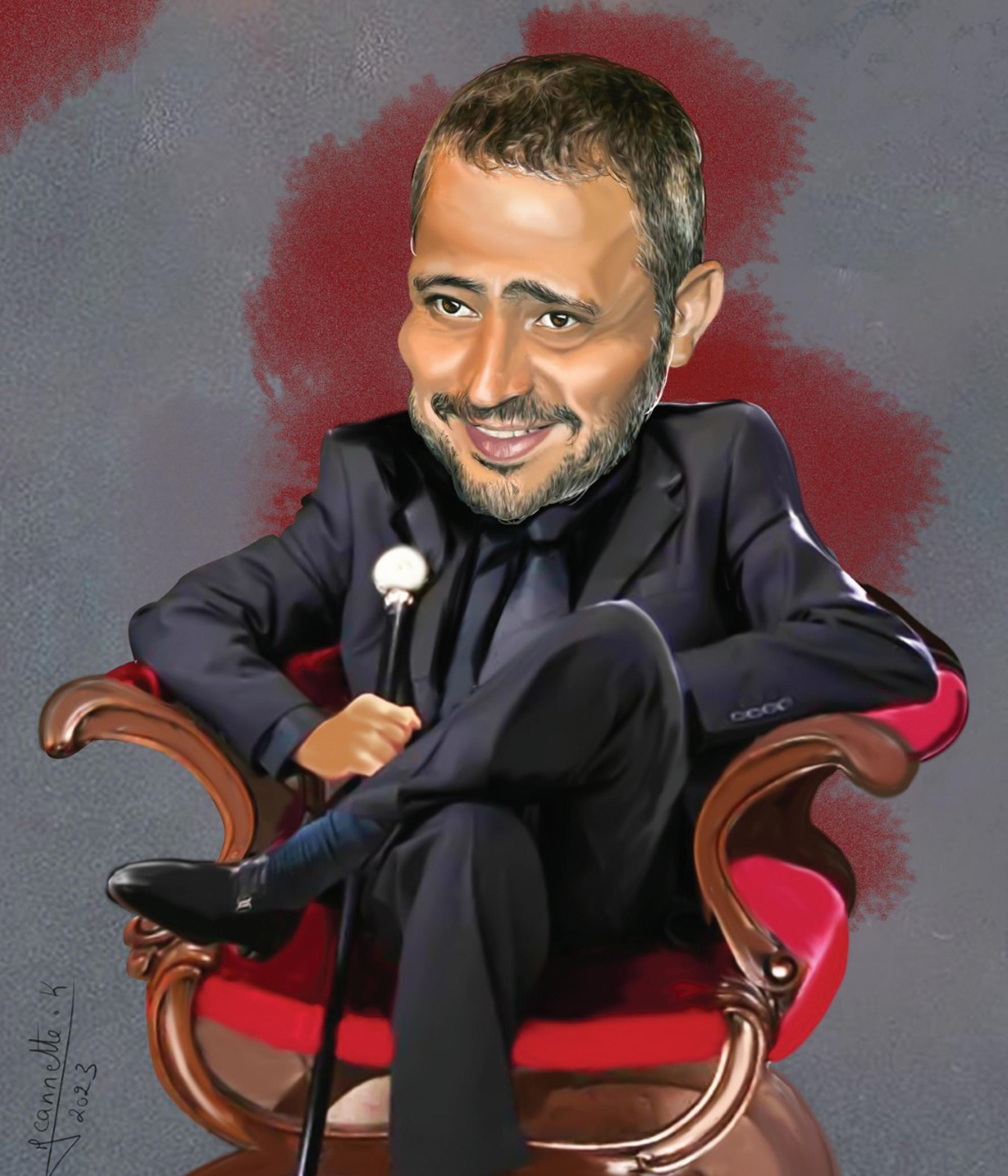


As Jesus did not say – he was more preoccupied with the poor on that particular occasion – the rich are always with us. In all probability, they’ve been around since the time of the cavemen: the same entrepreneur who came up with the wheel went on to commission the cave paintings. As I will demonstrate in my next article, they are now preparing to survive us by returning to the caves, only this time the décor will be a bit more sophisticated. In this way, they hope to escape whatever apocalypse befalls human civilisation: flood, fire, nuclear
winter, plague, reality shows, etc. But I’m getting ahead of myself – which is perhaps the one thing ‘the rich’ and I have in common. On my regular journeys from London to Bath, I have grown accustomed to seeing these words as my train leaves Paddington station:
A quick search on Google yields numerous examples of this sentiment throughout the Western world and beyond. Here is one with superior spelling to the Paddington example:
This one, a stencil version, helpfully provides cheap cutlery:
While this one manages to make the whole idea seem innocuous with the addition of a smiley face:
And yet, the phrase is really not innocuous. It is, at best, a modest proposal along the lines of Jonathan Swift’s plan for alleviating poverty among the Irish, by selling their children as food to well-off gentlemen and ladies. Except this injunction comes with a populist twist: the poor will be doing the eating, not the feeding. The phrase did not start out as an imperative, however, but rather as a somewhat alarmist observation by the Swiss philosopher, JeanJacques Rousseau, on the plight of the starving poor, to wit “When the people shall have nothing more to eat, they will eat the rich.” That this got reduced to three words is hardly surprising; the original was a bit of a mouthful for any sloganeer or aspiring graffiti artist. It was, nonetheless, just the kind of careless talk that enraged my philosophy tutor at Peterhouse. He readily forgave me for turning in an inferior essay on Rousseau “because the man was such a little sh*t.” In certain parts of Cambridge, they had yet to forgive him for the French Revolution.
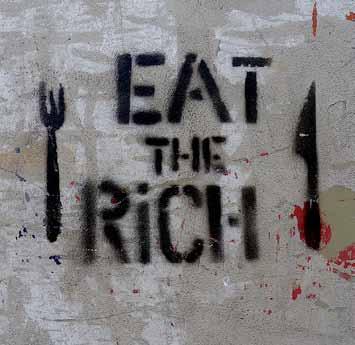

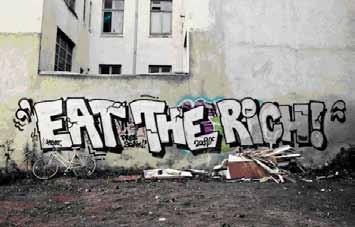
Yet revolution did not come again to Britain’s shores. Having got the idea of decapitating our monarch long before the French, we shop-
keepers had settled on a form of constitutional monarchy which allowed us to lampoon the royals, while keeping them ensconced in their palaces. As time wore on, the popularity of the royals fluctuated. One only has to watch The Crown on Netflix for evidence of that. Indeed, the popularity or otherwise of the monarchy – or ‘the firm’ as the late Queen liked to call it; the Duke and Duchess of Sussex prefer ‘institution’ with the sly implication that the royals have taken over the asylum – has become a national preoccupation. Those fallible individuals who belong to it are the closest we have to a national dish. They are delicacies far more easily exported than, say, roast beef and Yorkshire puddings. Foreign palates find them even more agreeable than chicken tikka masala. The royal family is to the British Isles what pizza is to the Italian peninsula: it is consumed in vast quantities by foreigners, and among these the Americans have become particularly partial to it, despite having chosen to forget the recipe. Nowadays we do not speak of eating anyone. Cannibalism may still occur, from time to time, in Germany, but the royal family cut ties
It started out as a somewhat alarmist observation by Rousseau, on the plight of the starving poor, to wit “When the people shall have nothing more to eat, they will eat the rich.”Proper Spelling EAT DA RICH Cheap Cutlery

with German ways long before Uncle Eddy tried teaching the princesses the Nazi salute. As far back as 1917 they dropped the family name of Saxe-Coburg and Gotha (another mouthful) and became simply ‘the Windsors’. Since then, cannibalism of any sort has been off the dinner table. The royals went native, and their people learnt to accept them as quintessentially British. Thus, though they may look good enough to eat, our relationship with this over-privileged relic of a Bavarian duchy smacks of ‘cakeism’: we have found the perfect way of having our cake and eating it. In the eyes of today’s more caring cannibal, the royal family are the finest, most ridiculously ornate, trembling, many-tiered, some would say overbaked (like this one) metaphor. We consume them, but strictly metaphorically. As a result, Rousseau’s line about eating the rich has lost the capacity
to chill blue blood. In the British royal family, we have come up with an infinite supply of chewing gum for the eyes. It induces an illusion of surfeit in both royalists and republicans alike. The royalists have sufficient to feast their eyes on, while the republicans have enough to revile. Back in the Sixties, the first real attempts were made to feed the nation’s curiosity, with shots of the corgis running across royal lawns and Prince Philip barbecuing for England. More recently, Netflix has joined in, with splendid accounts of the family history, depicting a sweeping, majestic arc that culminated this Christmas in the collapse of the marriage of Prince Charles and Princess Diana. It was nostalgic fare, but really the audience craved fresh meat. Netflix obliged and, in cahoots with Prince Harry, son of the calamitous Diana, and his American wife, Meghan Markle, produced a six-part epic about their various ruptures, with the press and with the institution. The royalists and the republicans have been happily stuffing themselves ever since, while the Duke and Duchess of Sussex look set to be dining out on their ‘truth’ in perpetuity. What could possibly go wrong?
In my next piece, ‘How to Avoid Being Eaten’, I shall be looking in more detail at the kinds of things that can possibly go wrong. As life coach to the rich and famous – you surely didn’t think I got this rich on penning articles – I have long advocated that they shun publicity. Obviously, I cannot reveal too many professional secrets here. The world’s press would descend on my clients the moment I breathed a word. Let me confine myself, therefore, to a general observation, rather along the lines of the great Swiss philosopher: the modest rich would do well to retreat from the public gaze altogether. It just so happens that I know of one suitable location, ideal for all wealthy persons with that hunted look. It is an island, a fact which I know is recommendation enough already. But this particular island, though it was once sacred to a sun god, is nowhere near the Caribbean. In fact, no sun-worshipping billionaire has ever heard of it. The locals are simple folk who farm on terraces, herd sheep and always wrap up warm. The women wear the same black hats once decreed by the King of Spain. In this place, I absolutely guarantee, no wealthy fugitive will ever be tracked down by some freelance pap hoping to sell his pictures to the Daily Mail. There is no need to go about in disguise, shave off one’s ginger beard or even work on one’s high school Spanish. The locals will treat you with perfect indifference

Having got the idea of decapitating our monarch long before the French, we had settled on a form of constitutional monarchy which allowed us to lampoon the royals, while keeping them ensconced in their palaces.Smiling ‘Eat The Rich’ A case of letting them eat it
and you can enjoy a lifestyle as carefree as any peasant.

But hey, I will leave it at that. Potential clients know where to find me for a private consultation, impeccably discreet, no upfront fee. Even a half-sentient being living under a rock could not have missed the consuming interest taken by the anglosphere in the royals. In the recent holiday season alone, we have been treated to ten more episodes of The Crown. Peter Morgan must qualify as the Holinshed of the twenty-first century. This time, however, the casting was problematic. Imelda Staunton got the voice just right, but looked like the obvious choice for her own mum, while the actual choice looked like an emaciated teetotaller. As for Prince Charles, Dominic West made a valiant effort to adopt the heir to the throne’s tics and plummy accent, but in his portrayal of gawkiness he was battling with his own
deportment. As the Duke of Edinburgh, Jonathan Pryce was totally miscast, the victim of a complete humour by-pass who embarrassed us all by flirting with a woman half a century his junior if she was a day. This miscasting of the main characters introduced a kind of vertigo into the proceedings, as we saw the actors verge on caricature, only to pull back at the last moment. There were times when Harry Enfield would have done a far better job, even of the Queen. That way, they wouldn’t have needed the kind of money about to be squandered on the next moon landing.

Rising above this orgy of casting mistakes – I haven’t even mentioned the older Princess Margaret, as played by Leslie Manville, of whose performance the only convincing aspects were her chain of ciggies – was the casting director’s only true bullseye, the part Elizabeth Debicki was born to play. Her Diana was uncanny. There are times it was so good, one had no disbelief left to suspend. It was as if the Queen of Hearts had stepped back onto the scene, and walked and breathed amongst us once again, treading gingerly through minefields, both figurative and literal. Debicki was the real thing. When she stepped out of the limousine in her ‘revenge dress’ with all the
fatal allure of the original, she captured a beauty that, heretofore, has been Diana’s alone: sexy, yet still slightly ungainly, as if a trace element of Camilla’s frumpiness had arrived at the wrong address; as if, indeed, the casting of the real-life royals had been as mixed up as that of its fictional equivalent. If anyone doubts my assessment, just watch the eighth episode entitled ‘Gunpowder,’ in which, amid the sound of fireworks being let off, Diana grows a pointy beard, creeps under the Establishment and blows everything sky high, whilst maintaining the demeanour of doe-eyed innocence. Whisper it for fear of eavesdropping flunkies, but the other series Netflix has given the Englishspeaking world threatens to outdo the gunpowder plotter’s wildest fantasies. It may not have the artistic qualities of The Crown, and if Peter Morgan gives us recent history, well within living memory for anyone who can bear to remember it, Harry & Meghan gives us history so recent it would be impolite to Clio, the muse of history, to mention her in the same breath; as a rule of thumb, one avoids making a lady feel her age. For those rare souls who have been spared the bleating of ‘the spare’ and his wife over six episodes, in a spirit of self-sacrifice, and also because, given it was Christmas, I had nothing better to do, I have watched the whole lot so you don’t have to. I will now take you through it at breakneck speed. Before I do so, however, let me just say that it wasn’t half as awful as I expected. Call me soft. Blame the tipsiness of the season and its proneness to mawkish sentimentality. But seriously, I was not in anywhere near the mental anguish I expected to be by the end. If I were a republican masochist, I would be demanding my money back. As the chronology of the account is fairly rigid, there is some excruciating early stuff on how Harry met Meghan, which comes across as how Hammy met Silly, without the faked orgasm in the diner. It’s easy to be cynical, but who can blame them for this little bit of
The royal family is to the British Isles what pizza is to the Italian peninsula: it is consumed in vast quantities by foreigners, and among these the Americans have become particularly partial to it.The island I have in mind, somewhere in South America Enfield as Prince Charles
starry-eyed absorption in each other, given the story about to unfold? They found love, to the relief of anyone forced to watch the tentative beginnings, apparently in a tent deep in the African bush, their dream only interrupted by the rustling of big game nearby, which is nowhere near as scary as the rustling of photographers in bushes. Even this early on, they knew what to expect when the world got wind of their romance. Meghan had tasted a bit of fame already, as an actress. For Harry, thus far a popular act in the royal variety performance, it would be a disaster foretold by his own childhood. As the documentary puts it, the royals are under a very clear obligation to the British press: We [the people] pay; you [the royals] pose. How else are we to extract any value from them?
she says. Cue the absurd ‘straight outta Compton’ slur. Because Compton lies a few miles from the scene of Meghan’s childhood, we are supposed to associate her with the NWA and the birthplace of gangster rap. You try bouncing an Ascot Landau.

Things escalated quickly. By the fourth episode we have Prince Charles gently remonstrating with Harry: “Darling boy, you can’t take on the media!” Yet a baby shower fiasco follows, with Meghan criticised for being too extravagant. Attacks and insinuations from the press become relentless. From here on, I really wondered why a life as South American peasants had never occurred to them. They are pursued by paparazzi wherever they go; a letter to her troublemaking father, though heavily redacted, is leaked to the Mail; the institution leaks the story of them giving up their duties to go to Canada, and once they get there, palace security is withdrawn; Meghan gets the blame for ‘Megxit’ and, as Olusoga says, the tabloids ‘monetise outrage’. It’s all just as tawdry this time round as it was with Harry’s mother, but with the added poison of a Twitter backlash. This was ‘not your everyday trolling,’ apparently. It came from mostly white middle-aged women and made Meghan fear for her life. She describes it as ‘symbolic annihilation’. Someone even suggests that Archie, her little son, ‘should be put down.’
Enough!
And so it was with the ‘fairy tale’ wedding, though as Professor David Olusoga confesses, “you were slightly looking at it with your hands in your mouth.” At this point, before the fairy tale scenes are reprised, with their sunshine, their horse and carriage, the page boy with a toothless grin, Meghan is anticipating the treatment she will receive from the press: “they were gonna find a way to destroy me,”
…but I haven’t even mentioned the suicidal thoughts, the miscarriage, the… Basta, already! For this viewer, at least, it was necessary by this time to take a step back from the maelstrom. I have the good fortune never to have attracted the interest of a single paparazzo, not even during my brief affair with Princess Margaret, never to be forgotten, which remained platonic, and indeed a figment of my imagination, throughout my sojourn in Mustique. If you press me, I will admit I preferred Vanessa Kirby, never having been a big fan of la Bonham Carter.
From the privileged vantage of utter obscurity, let me say that Professor Olusoga is wrong – at the time of the wedding, I didn’t watch with my hands in my mouth. Not even slightly. I was happy that the royals had accepted a woman of colour into the fold, that Harry was smitten, that the public were enchanted, etc., etc. It never crossed my mind that one day these newlyweds would be seeking refuge in California, of all places. I never even imagined that the hitherto saintly Jeremy Clarkson would admit to fantasies about Meghan being stripped naked and paraded down the public highway, while extras from the Game of Thrones hurled dung at her; that this same upstanding pillar of modern British society, who never knowingly expressed a controversial thought in his life, would compare her to Rose West,
Could it be that H and M – as they call each other in the film – have made a bigger mistake than either of them cares to acknowledge? They have opted to get out of the family firm and decamp to the States.NWA
a serial killer from Gloucestershire, just up the road from his farm. There were two very telling moments for me in the course of this epic of dashed hopes and bullying by the likes of Jeremy Clarkson. They both illustrated an awareness, however concealed in cliché, of the way that the royals have become the world’s favourite dish. In the first instance, Harry explains how they didn’t want their baby ‘served up on a platter.’ In the second, Meghan is heard bemoaning the way they were ‘not just thrown to the wolves, but fed to the wolves.’ The first time I heard this, I struggled to see the distinction. That’s because there really isn’t any, just a change of emphasis from being left to the wolves’ mercy, to the frenzied consumption that would follow. Not for the first time, something has gone wrong with the model that has kept the house of Windsor chugging along all these years, through every adversity the writer of The Crown could chuck at them. From being consumed visually, in the controlled manner of more deferential times, the sensation has become one of being eaten alive. Surely nobody could actively desire such a fate, could they? On the eve of the publication of Prince Harry’s book, rather sparingly entitled Spare, could it be that H and M – as they call each other in the film – have made a bigger mistake than either of them cares to acknowledge? They have opted to get out of the family firm and decamp to the States. There, as we have seen, an ambivalence towards the royals prevails. The death of the Queen, for example, triggered an immediate outburst of anti-royal sentiment. Within minutes of the news crossing the Atlantic, one academic had kicked things off with a denunciation of the colonial attitudes enshrined in the monarchy. An outpouring of righteous indignation ensued, as I described in my article ‘Speaking of the Dead’. In Harry and Meghan’s documentary, a similarly hostile position lurks behind Afua Hirsch’s reference to the Commonwealth as ‘Empire 2.0.’ When she declares that the departure of the fairy tale couple ‘felt like the death of a dream,’ her composure is exemplary.
Obviously, the Sussexes are not over-fond of the media, darling boy, but there is also a critique of the monarchy here that threatens to break cover at any moment. In England, this may still be the lack of love that dare not speak its name. In the States, it can be shouted from the rooftops. Over in the land of the free, hating the monarchy is a badge of honour. It is this difference that persuades me that Harry has opted, not for a life where he and his wife cease to be consumed, but for different consumers. This way, they can keep the role they know best: as public comestibles.
It was Dean Acheson who said Britain had lost an Empire and not yet found a role. He said this back in 1962, just a year before what Philip Larkin called the Annus Mirabilis: ‘Sexual intercourse began
In nineteen sixty-three (Which was rather late for me) –
And the Beatles’ first LP.’
For the benefit of younger readers, the Beatles were the original Fab Four, long before William, Kate, Harry and Yoko… sorry, Meghan… were even twinkles in their fathers’ eyes. On the arrival of the Beatles from ‘up north,’ London, formerly the frigid heart of Empire, promptly began swinging, and soon after that the British invasion of America began. It was a role of sorts.
To this day, there are those who quote Acheson favourably, but sometimes it seems to be the Americans themselves who can’t get over the Empire, just because they can never quite live down ever having been part of it. The grievance is perpetual, it can never be appeased, and Harry can capitalise on this. He has found the secret of perpetual emotion. To answer my own question: No, H and M haven’t committed an obvious mistake; there’s a great deal of dosh to be had from making Americans feel better about themselves. Start by slagging off the family members, and when that seam is exhausted, move onto trashing the ‘institution’. In the form of a disaffected prince, it’s quite possible we are seeing an entire constitutional monarchy eat itself. After watching its slow, agonising torture at the hands of the right-wing papers, that sounds like a mercy killing.
Before the fourth episode of the documentary settles down to footage of the wedding of Harry and Meghan, we first see the marriage of Elizabeth to Prince Philip. Describing the nuptial scene, pictured in grainy black and white, is a fawning royal commentator. He is burbling on about the pageantry and the splendour of it all.
So far, so predictable, only the voiceover on this occasion was remarkable for one thing, which overleapt temporal distance and foreshadowed an unpalatable future: the commentator’s accent was American.
Prince Harry’s book, Spare, is due to appear in bookshops on the 10 January. The Guardian newspaper has warned its readers that the book includes an account of a ‘physical attack’ by Prince William after he followed his brother into the kitchen. As a result, Harry fell backwards, smashing the dog’s bowl. The dog, we are assured, was not eating at the time.
As the documentary puts it, the royals are under a very clear obligation to the British press: We [the people] pay; you [the royals] pose. How else are we to extract any value from them?
The saga of Rayya and Sakina, Egypt’s most notorious serial killers who murdered and robbed at least 17 women and buried them under their house (with the help of their husbands, Hasaballah and Abdelaal, and a few family friends), is still fresh in the country’s collective memory. The duo’s heinous murders in twentieth-century Alexandria continue to inspire films, plays, and books.
The sisters worked in several brothels before leaving Tanta for Alexandria’s ElLabban street. However, when they moved to Alexandria, they began killing—not out of malice, but for financial gain, as they (like many Egyptians at the time) faced se-
vere financial difficulties.
The old house that witnessed the massacres of Rayya and Sakina is a few meters away from Alexandria’s El-Labban Police Station. These grim tales occupied Egyptian public opinion for years after it was discovered that they recruited women and slaughtered them, afterwards seizing their gold jewelry.
Rayya and Sakina’s house, which was demolished and replaced by another building after the incidents, is located inside the ElLabban neighborhood, west of Alexandria, and is near the yellow tram line, Alexandria’s most famous mode of transportation. However, families and neighbors still retell the most famous and true stories that they
heard from their fathers and grandfathers about the first women who were executed in history on charges of murder.
The most famous crime case in Alexandria’s history during the twentieth century is “Rayya and Sakina.” Majalla filmed scenes of the gang’s house, which has been turned into a tourist attraction, with paintings depicting the legend of evil hung on its old walls. The display alternates between images of the victims and the officer who discovered the crime, as well as Bade’ea, Rayya’s only daughter, in addition to photos of Hasaballah and Abdelaal and others, documenting the arrest of the accused and the exhumation of the victims’ bodies.

According to Metwally Abdelaal, a local, Sakina first moved into the house before her sister Rayya joined her. The bodies of Rayya and Sakina’s victims were exhumed from inside the house, while the rest of the victims were still inside their former home on Ali Bek Al Kabeer Street.
He went on to say that the crime was discovered because of the smell of the victims, as well as the sewage excavations that revealed the victims’ bodies. It was Sakina’s wearing a shawl given to one of the victims, Firdaus, by a British Khawaja, that paved the way for this. After killing her, Sakina grabbed the shawl and put it on. The British Khawaja saw her wearing it and ac-
companied her to the El Labban Police Department, where the police and the Public Prosecution Office began investigating the women’s disappearance.
Rayya and Sakina would entice these women into their home, serve them a welcome drink, and then get them drunk enough that they couldn’t move.
When the victims were sufficiently drunk, the sisters and their husbands would strangle them, strip them of all their jewelry and fine clothes, and bury them beneath the floor tiles. Afterwards, they would sell all of the valuable items.
Fortunately, a police officer noticed something fishy going on in the sisters’ home and decided to report them. The man had no idea, but he had unintentionally saved the lives of the gang’s intended victims.
The saga of Rayya and Sakina, Egypt’s most notorious serial killers who murdered and robbed at least 17 women, is still fresh in the country’s collective memory.
Metwally Abdelaal went on to say that the people of Al-Labban know every detail of the story of the two most famous butchers in the history of the judiciary. Insofar as the house has become a destination for many Alexandrians as well as visitors from neighboring governorates or other cities, the locals turned it into a tourist shrine to learn about the history of Rayya and Sakina, which is illustrated by prints ranging from the first images of their victims to the documents of their execution.
He denied the patriotism of the two butch-
ers of Alexandria who attempted to seize British soldiers at the time.
“I have the honor of being the first woman to be executed and standing in a place where only men can stand,” Rayya said on the gallows, becoming one of the judiciary’s first two women sentenced to death.
Abdelaal added that the third house is in the Al-Najat neighborhood, from which two other bodies were extracted. However, this house and others either belonged to families who still live in them, or are abandoned because the heirs refused to sell them or there were disagreements over the sale.
He went on to say that as the years passed, they fell into disrepair, and one of their old houses was demolished and replaced with a new one. It has since housed a number of families, who were terrified of the ghosts of victims who had been killed in the past.
He concluded that, after more than a century, the saga of Rayya and Sakina remains immortal for the people of the region, and for the multiple visitors to the city who learn about Egypt’s ugliest murder story.

“I have the honor of being the first woman to be executed and standing in a place where only men can stand,” Rayya said on the gallows, becoming one of the judiciary’s first two women sentenced to death.The House of Rayya and Sakina in Alexandria - Photo Credit: Sarah Gamal
Following a widely publicized trial, the majority of Rayya and Sakina’s victims were revealed, and the sisters and their husbands were executed. Rayya’s daughter, Bade’ea, on the other hand, was an important witness who helped bring her family to justice and was sent to an orphanage after their execution. Unfortunately, Bade’ea died in an orphanage fire at the age of sixteen, though no one knows whether the fire was intentional or not.


Handwritten legal reports and investi-
gations in Dar al-Mahfuzat and the Bibliotheca Alexandrina suggest that the two women were used as scapegoats to target Alexandria’s clandestine sex workers. The case was widely distorted into a tale of infidelity and moral bankruptcy when, in reality, it was a series of homicides carried out for monetary gain by a gang of six members.
The gruesome, complex story of the murders captivated mass audiences and imaginations over the years, culminating in the story being embodied in film (1953, 1955, and 1983), a 2005 TV series starring Egyptian actresses Abla Kamel and Somaya El Khashab, as well as theatrical productions.
Rayya and Sakina would entice these women into their home, serve them a welcome drink, and then get them drunk enough that they couldn’t move.Sakina (Left), Raya (Right) real mug shotPhoto Credit: YouTube
What defines the Christmas season? Is it tradition and custom, or perhaps decorations, lights, sparkle, and glitz? Is it the excitement of the build-up, or relaxing, taking time out from our busy lives for some home comforts?
Is the holiday associated with jetting off to exotic climes, or is it about reconnecting, seeing family maybe, re-visiting the places of our youth?
By Luisa Markides
For those living in England’s capital, including all the many expats living in London, there is a great deal on offer, with both more time and more space to enjoy it. The great metropolis - normally frantic and abuzz – feels decidedly quiet at the end of the year. Streets feel emptier. Traffic lighter. Its pace altogether slower, as if the city is taking a breath, gearing up for New Year.
For lovers of art and classical music, the choice of distractions is mesmerising. One of the many brilliant ways to spend two hours is to catch a showing of ‘The Snowman’, based on the classic children’s wordless picture book and beloved at this time of year. A British production from Raymond Briggs dating back to 1978, ‘The Snowman’ is most closely associated with its enigmatic soundtrack, with music composed by Howard Blake, including that most iconic of songs, ‘Walking in the Air.’
Another ageless festive staple offered by London in December is ‘The Nutcracker’, perhaps the world’s most famous ballet, based on a magical world in which a child’s toys come to life at the stroke of midnight. The girl’s nut-
cracker – a doll of a toy soldier with origins in German folklore – is the hero of this tale, while the evil Mouse King is most definitely the villain. This is the ballet that inspired virtually every other.
Based on a story from 1816 by Prussian author E.T.A. Hoffman, this Christmas fairy-tale only became a ballet when Ivan Vsevolozsky, director of Moscow’s Imperial Theatres, first commissioned it in 1891. Its music came from Russian composer Pyotr Illyich Tchaikovsky, shortly before his death, while the original choreography came from French ballet dancer Marius Petipa, whose prolific career centred around St Petersburg where, a week before Christmas in 1892, ‘The Nutcracker’ debuted at the city’s Mariinsky Theatre.
It was here that a well-heeled Russian audience first heard some of what would become ballet’s most memorable songs, including ‘Russian Dance’ and, of course, ‘The Dance of the Sugar Plum Fairy.’ Interestingly, Tchaikovsky was none too impressed with ‘The Nutcracker,’ later writing that it was “infinitely worse than Sleeping Beauty, of this I am sure”. Indeed, he turned down the initial commission and needed to be persuaded to deliver the compositions we all now know so well.
On its legacy, at least, he appears to have been a poor judge: it quickly became a hit and has remained so ever since. For almost half a century the Russians kept it to themselves, only
.
Not only has this ballet survived the test of time; it has inspired generations to dream, while serving as an introduction to classical music for countless children and young adults
exporting it in 1934, when the ballet came to England. It landed in San Francisco a decade later, in 1944, and from there it headed east to New York City, its popularity having grown after Walt Disney used some of Tchaikovsky’s music from ‘The Nutcracker’ in his animated musical film, ‘Fantasia.’ Today, ‘The Nutcracker’ is performed across many different London theatres over Christmas, but surely one of its most renowned venues is the magnificent Royal Albert Hall, where this two-act festive favourite comes alive through the world-class dancers from Birmingham Royal Ballet and an incredible full symphony orchestra above the stage. A delight from start to finish, in this correspondent’s opinion few other versions even come close.
The story begins with Clara and her family hosting a Christmas Eve party. Her mysterious godfather, Dr Drosselmayer, has been invited. This skilled toymaker, who is always full of surprises, gifts Clara a nutcracker, with which she falls in love. When the guests depart and the family retire for bed, Clara worries about her beloved nutcracker, so she sneaks back to the Christmas tree and falls asleep with it in her arms. Then, on the stroke of midnight, the nutcracker and all the other toys come to life. Thus begins their adventure –through snow and magic. The nutcracker becomes a prince who encounters both the evil Mouse King and the Sugar Plum Fairy, before finally carrying Clara back to the Christmas tree and safety, where she awakens, her beloved nutcracker still under her arm.
The audience’s visual and audible appreciation on
the two sold-out nights showed how this was one of the most sophisticated performances of this worldfamous ballet, with stunning lighting, majestic period costume, and world-class projections. The whole production was a masterclass in art and elegance. A family of four, whose evening there was a Christmas present for their six-year-old daughter, described it as “absolutely wonderful and amazing”. The youngster’s favourite part? “When Clara was dancing!” She then described how she was doing ballet herself, before confidently demonstrating a pirouette.
Not only has this ballet survived the test of time; it has inspired generations to dream, while serving as an introduction to classical music for countless children and young adults. Sarah, another young mother in the audience, said she took her daughter to see the show for the first time when she was four years old. “I will never forget the sparkle and wonder in her eyes. Straight after, she asked to enrol in ballet classes and has been dancing passionately ever since.”
Another couple, whose child was left similarly enchanted, agreed that Christmas “would not be complete without a trip to the Nutcracker”, adding: “This production was the most magical one we have seen. From the giant baubles appearing in the air to the snow falling, it was a festive treat for the whole family.”
As the author Roald Dahl once said, those who don’t believe in magic will never find it. If ever you are in London over Christmas, my advice is to go in search.
Standing Ovation. An evening performance of ‘The Nutcracker’ at the Royal Albert Hall is hard to beat at this time of year.


Syrian singer George Wassouf made a remarkable appearance on New Year’s Eve at the Trio Arabic Night which was organized by the Saudi Entertainment Authority in Riyadh.
An exceptional evening was enjoyed by the Riyadh audience which included a large number of the most prominent Arab stars at the Mohammed Abdo Arena Theater at the Trio Arabic Night concert in Riyadh on New Year’s Eve 2023.
Wassouf, who was clearly happy during the presentation of his singing segment, performed as a trio together with Lebanese singer Nancy Ajram and Tunisian singer Latifa and sang “Kalam al-Nas,” which is considered one of George’s most famous songs. They were accompanied by Lebanese singer Nawal Al Zoghbi and Tunisian singer Saber Al Rebai.
Wassouf, 61, has had a long career span-
ning four decades during which he released more than 30 albums for a significantly large audience of fans throughout the Arab world.
Wassouf is dubbed the Sultan of El-Tarab, having sold over 60 million records worldwide.
Wassouf was born into a family of five children in the Syrian village of Al-Kafroun. His beginning in the arts was at the age of fourteen, when he became famous in Syria through his singing Mawal “Hasbaya.”
He moved to Damascus to sing in the Green Garden Restaurant, but the Musicians Syndicate issued a decision banning him from singing because he was not eighteen years old.
However, an admirer of his talent intervened and allowed him to sing on the pretext that his voice was older than his age.
After his fame grew locally, he moved
to Lebanon when he was not yet sixteen years old. The artist George Yazbek and the artist Wadih Al-Safi sponsored him artistically.
He collaborated with composers such as Sayed Makkawi, Shaker Al-Muji and Baligh Hamdi, and he presented many works with them. His song Al-Hawa Sultan became famous, as a result of which he received the title “Sultan El-Tarab.” He participated in the amateur program “Studio El Fan” in 1980.
He met his wife, Shalimar, while performing at a party when he was nearly 21 years old. The civil marriage took place in Paris because her family rejected the match. In other words, when he proposed to her, her family refused him, so he married her without their knowledge.
His second marriage was with the Qatari-Palestinian rally champion, Nada Zaidan. She revealed that she met Wassouf at Aspetar Hospital in Qatar, where she works as the head of the Players Affairs Department.
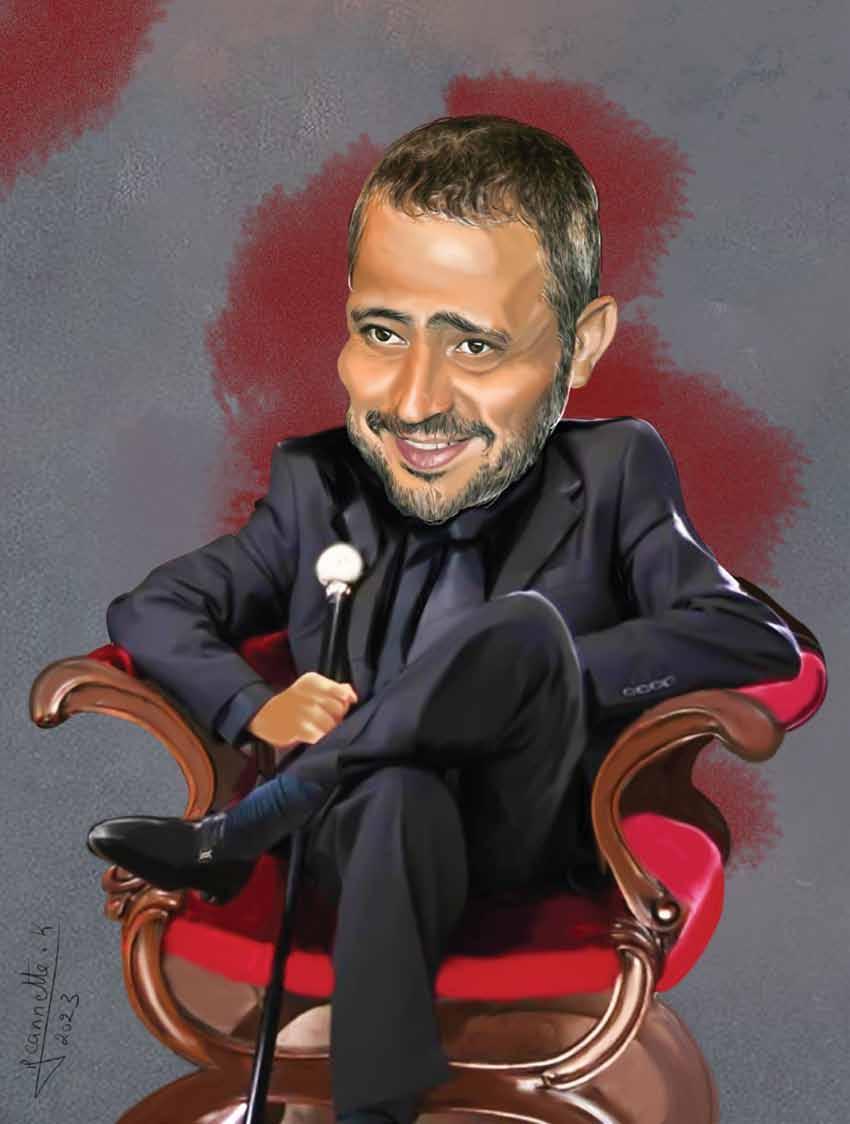
One of the nice things about the tech world is just when you think things have reached their peak, a new summit appears in the distance.
2022 had plenty of new tech, from smart watches that can call for help if you’re in an accident to art created by artificial intelligence that we all couldn’t keep from showing off to the world. And while some of the real treasures of 2023
won’t be unveiled until CES in January (or later), there are already several things that have us eager to learn more.
Here are some of the things that are already piquing our interest.
Apple’s entry into the virtual- and augmentedreality space has been one of tech’s worst kept

secrets for some time. What has been less clear is when, exactly, the company would showcase some of those plans. Increasingly, though, it appears 2023 might finally be the year (though it now appears that will happen in the back half).
Apple industry analyst Ming-Chi Kuo has called the mixed-reality headset a “game changer” that “will further boost the demand for immersive gaming/multimedia entertainment.” The headset has also been referred to as the most complicated product Apple has designed.
Apple has a built-in ecosystem of users, and it has the resources to loop in top developers. Most importantly, unlike Google, it has patience. AR/ VR might be a slow burn for the company, but if it shows steady growth and Apple continues to support it, it could finally bring the technology closer to the mainstream.
Sony had an advantage when it released the first PlayStation VR in 2016. The system was cheaper than the then-new Oculus Rift, didn’t require a high-end computer and, while not wireless, was much less cumbersome than other VR headsets at the time. It also launched with game franchises people knew. The device sold more than 5 million units.
So, the second generation, releasing on February 22, has a lot to live up to, but it doesn’t launch with the same advantages.

The base model costs $550—$150 more than the Meta Quest 2. That works against the system, but the game lineup features some major Sony franchises. And the visual upgrade, from the tech specs, is light years better. There’s also haptic feedback. And a vastly better tracking system. It will all come down to the games, but PSVR 2 could lure hardcore gamers back to VR.
Speaking of Meta’s VR headset, the long-awaited update to the Meta Quest 2, is also expected to come in 2023. In October, Meta CEO Mark
Zuckerberg told Stratechery that the device would likely be in the $300 to $500 range, similar to the current model. Although we don’t know many other details yet, the headset is rumored to feature a graphics upgrade and possibly even support for mixed reality.
The rise of DALL-E and Lensa this year has given AI art a big buzz factor. Microsoft and Canva are already incorporating generative AI into design tools; and in 2023, photo and video behemoth Adobe plans to dive in as well. The company aims to use generative AI to greatly simplify the tedious process of compositing images. It will let someone find and pull highlights from video content using voice searches in a service called Project Blink (currently in beta). You’ll be able to edit out distractions easily and even change people’s apparel in photos, if the tech lives up to its promises. You’ll even be able to move people or objects in photos and have them cast realistic shadows.
2023 is shaping up to be the year of AI video. Just as AI photos can be generated by suggestion, new systems (like Meta’s Make-A-Video and Google’s Imagen) are ramping up and letting users turn text prompts into unique videos.
“Generative AI research is pushing creative expression forward by giving people tools to quickly and easily create new content,” said Meta when announcing the tool. “With just a few words or lines of text, Make-A-Video can bring imagina-
“Generative AI research is pushing creative expression forward by giving people tools to quickly and easily create new content.”Credit: TNS
tion to life and create one-of-a-kind videos full of vivid colors, characters, and landscapes. The system can also create videos from images or take existing videos and create new ones that are similar.”
An Android competitor to the iPad from Google would be enough to turn heads all on its own. But the Pixel tablet gets extra attention as it’s the first stab at the market in five years.
The system will run on the same Tensor G2
chipset that powers the Pixel 7 smartphones, and it can magnetically attach to a speaker dock, effectively turning it into a smart display (like the Nest Hub Max). Google declared last year that tablets are the “future of computing,” and it’s now trying to spark the category. The Pixel looks like an interesting start that incorporates itself into daily life.
While a new processor and camera upgrades are a certainty, the thing that has us most excited about the 2023 crop of iPhones is the possibility that Apple will finally embrace USB-C charging. The European Union has mandated that all phones sold there must support the technology by 2024 and Apple has said it would comply.

That would let people in the Apple ecosystem charge multiple devices with the same cable, dramatically increasing convenience.
This article was originally published by Fast Company.
While some of the real treasures of 2023 won’t be unveiled until CES in January (or later), there are already several things that have us eager to learn more.Credit: ADOBE STOCK

Hair loss doesn’t typically cause pain, but it can be emotionally distressing when you realize that your hair is thinning, especially if you can see space in between hairs and your scalp peeking out in places. Fortunately, there are a number of ways to treat thinning hair and keep the problem from advancing.

Two common conditions account for most age-related
hair loss.
The most common is androgenetic alopecia, also called male- or female-pattern hair loss. Thinning hair is the first sign. “Hair follicles become smaller, which makes the hair strands finer. Some hair follicles stop producing hair altogether,” says Dr. Kathie Huang, co-director of the Hair Loss Clinic at Harvard-affiliated Brigham and Women’s Hospital and assistant professor of dermatology at Harvard Medical School.
This type of hair loss can result from genetics or agerelated hormone changes. It occurs gradually, in patterns
specific to men and women. “In men, the front hairline tends to recede, or they might have thinning at the temples or the crown on top of the head. In women, it can involve most of the scalp, or affect certain areas such as the middle part, the temples, and the frontal scalp area,” Dr. Huang says. “But in androgenetic alopecia, women do not develop balding the way men can.”
Another common type of hair loss is called telogen effluvium. This type of thinning occurs suddenly, often as a reaction to emotional or physical stress. “It might happen after you’ve had a high fever, a urinary tract infection, or surgery. Shedding can also occur as a reaction to an underlying medical condition or from taking a new medication,” Dr. Huang says.
Your primary care physician can assess whether you have hair loss caused by an underlying condition, medication, hormone changes, or aging. The doctor may order blood work or prescribe treatments. If you want to see a specialist, visit a board-certified dermatologist who specializes in hair loss treatment and is well versed in the many options available to help regrow hair.
The type of treatment your doctor prescribes will depend on the cause of hair loss. Telogen effluvium corrects on its own or once the underlying cause is treated. “Telogen effluvium usually gets better in three to six months,” Dr. Huang says.
For people with androgenetic alopecia, treatment aims to enhance the hair follicles, so the hair strands become thicker and your hair appears to be denser over all. The following treatments may help.

Topical drugs. The FDA has approved minoxidil (Rogaine), available over the counter, as a hair loss treatment for both men and women. It helps thicken hair follicles and promotes hair lengthening. It comes in a liquid or foam that’s applied to the scalp. “If you have a lot of hair, it may be easier to apply the liquid form. But more people experience irritation with the liquid, compared with the foam,” Dr. Huang says. “And you have to use it on a daily basis for at least nine months to see improvement.”
Oral medications. Recent studies suggest that taking minoxidil as a pill, which has been used for decades to treat high blood pressure, is safe and effective for treating hair loss. “We’ve seen an increase in the use of oral minoxi-
dil for hair loss in the past year,” Dr. Huang says. “It’s helpful for people who aren’t getting enough benefit from topical minoxidil, or those who have scalp irritation from the topical form.”
Other oral medications to treat hair loss include finasteride (Propecia, Proscar) and spironolactone (Aldactone). “Oral medications can have side effects. For example, oral minoxidil can cause low blood pressure or heart palpitations. Therefore, we carefully tailor the treatment regimen for individual patients,” Dr. Huang says.
Platelet-rich plasma injections. In this procedure, high concentrations of components of your own blood are injected into your scalp to stimulate hair growth. Dr. Huang says each treatment can cost from $500 to $1,500. You typically repeat the process monthly, for three months, and require follow-up treatments every year. The effectiveness of platelet-rich plasma for hair regrowth is not yet proven.
Laser light treatments. Devices that emit low-level LED laser light might promote hair growth. They’re available (without a prescription) in combs and helmets that you use regularly in your own home. Prices range from a few hundred to a few thousand dollars.
Supplements. Supplements are sometimes expensive, and there isn’t solid evidence that they make hair grow. “But if they won’t interfere with your medications, it’s probably okay to try them,” Dr. Huang says.
And for any of these treatments, the key is starting them as soon as you detect hair loss. Once the follicles stop working, the only option to restore your locks is hair transplant surgery.
This article was originally published by Harvard Health Letter.
Your primary care physician can assess whether you have hair loss caused by an underlying condition, medication, hormone changes, or aging.Credit: FG Trade/ Getty Images
One significant development in business is the rise of financial technology, referred to as “fintech.” This is the growing integration of technology with finance in order to improve and automate financial services, thereby increasing the convenience of financial operations. In the past year, significant advances in fintech have been on the way in East Asian countries; this article will specifically discuss the rise of fintech in China.
interact with banks while developing a whole payment system for the internet.
By Saif Al-Abri
China wasn’t on the frontiers of modern finance. Before their entrance into the WTO, the whole system was running on cash, which meant they lacked credit assessment data. Of course, China could’ve easily caught up with the world by allowing western companies and their payment systems, such as MasterCard and Visa, into domestic markets. But they were reluctant, fearing it would harm their own payment procedures as they couldn›t compete with such experienced financial companies. As such, the process was slow; their first payment system was UnionPay which was very far behind to start competing and, due to multiple factors, wasn’t innovative. The first breakthrough in fintech was by the famous billionaire Jack Ma. He made two websites. The first was Alibaba, which is a business-to-business service. The second was Taobao, an e-commerce marketplace. This relates to fintech because Jack Ma noticed that consumers had trouble with payment. This is because they couldn’t pay with credit, which is usual for business interactions, and they don’t want to pay in advance as they don’t trust the other party in the exchange, hindering e-commerce growth. So, he created Alipay, which works like this – consumers pay, Alipay holds the money, and once consumers receive the goods, Alipay pays the producer. This brought about change as Alipay had to
Over time other companies joined in with Alipay. The first instance whereby these fintech companies came to compete with ordinary banks was when they started getting into real-life stores. One of their innovations was using QR codes instead of cash. Once this became the primary payment method, it opened multiple potentials. For instance, they went into the investment and debt markets, and then their significant innovations, or what some would call a dystopia, were the Super Apps. These apps are like Swiss army knives. They can do multiple services, including payments. Through these apps, you can pay for utilities, insurance, food, taxi, etc. Some with less technocratic affinities would call it a dystopia, as do you really want to have your real life all in one app for convenience? These applications are now being expanded beyond Chinese borders.
The story of China and fintech is extraordinary. From a country where you could barely access credit or any e-commerce without crippling obstacles to them now being advertized on your phone. These Super Apps have made China a formidable competitor, and it has just started. The new network and payment infrastructure it developed and the data gained can produce incredible innovation. However, there are downsides, especially regarding data accumulation leading to privacy concerns – as if the current businesses don›t have enough. Furthermore, during covid, it provided an easy way of controlling the population by providing a health pass with which you can only imagine the dystopic scenario it could bring about. For more on the topic, I would recommend “The Cashless Revolution” by Martin Chorzempa.




























